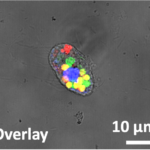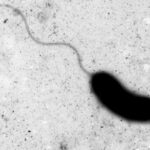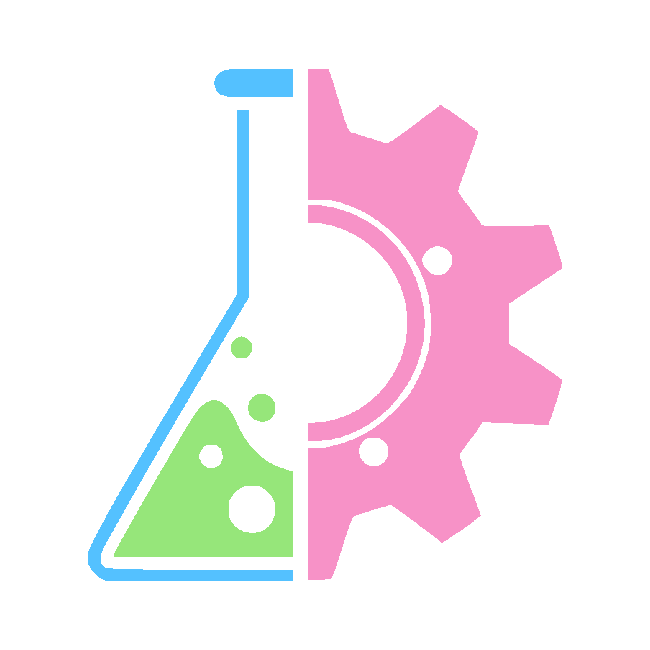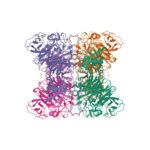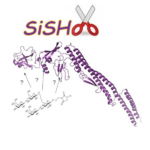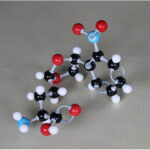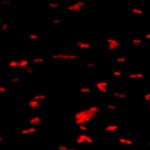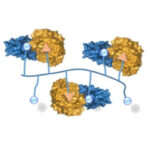Responsable : Cyrille GRANDJEAN
Objectifs : Développement d’outils et de méthodologies pour répondre à des questionnements de biologie ainsi qu’à des enjeux en santé et dans le domaine sociétal en glycosciences.
Champs disciplinaires : Glycobiologie, Interactions moléculaires, Biocatalyse, Enzymologie, Biotechnologies, Vaccinologie, Chemobiologie : Chimie pour explorer le vivant, Biologie synthétique, Voies métaboliques, Valorisation des ressources naturelles
Les glycosciences forment un domaine de recherche en plein essor qui étudie la science et la technologie des glucides qui sont les molécules biologiques les plus abondantes sur Terre, faisant partie de la biologie de tous les organismes vivants.
L’apport de l’équipe aux glycosciences s’inscrit dans trois axes :
- La glyco-enzymologie
La glyco-enzymologie au travers de laquelle l’équipe cherche à identifier, à caractériser et à modifier les propriétés d’enzymes impliquées dans le métabolisme des sucres (glycosides hydrolases, sulfatases) pour les utiliser en tant qu’outils synthétiques pour la production de molécules à haute valeur ajoutée.
- La glyco-technologie de la reconnaissance
Les interactions sucres/protéines (enzymes, lectines) sont au cœur de la communication cellulaire tant extracellulaire (interactions cellule-cellule, cellule-matrice, hôte-pathogène) qu’intracellulaire (GlcNAcylation en tant que modification post-traductionnelle). L’équipe travaille à la fois sur la conception de lectines artificielles que d’inhibiteurs dérivés de sucres afin de les utiliser en tant qu’outils pour cntribuer à la compréhension de processus biologiques que pour des applications en santé (diagnostic, anti-infectieux, anti-cancéreux).
- La glyco-technologie vaccinale
Il s’agit ici d’optimiser la réponse humorale dirigée contre les motifs sucres exprimés par les agents pathogènes dans le but de développer une nouvelle génération de vaccins glycoconjugués. Nos travaux s’inscrivent dans la validation de nouvelles cibles vaccinales, l’amélioration du process de production des vaccins grâce à la biologie synthétique, l’adjuvantation, la formulation sous forme de particules et l’étude des relations structure/immunogénicité.
Les glycosciences forment un domaine de recherche en plein essor qui étudie la science et la technologie des glucides qui sont les molécules biologiques les plus abondantes sur Terre, faisant partie de la biologie de tous les organismes vivants.
Mots-clés : acides aminés non-naturels, adjuvantation, bioconjugaison, évolution dirigée, fonctionnalisation métabolique, glyco-enzymes, glycochimie, glycoconjugués, ingénierie moléculaire, interactions protéines/sucres, microbiologie, mutagénèse, vaccins
Membres
Anciens membres de l'équipe
- Eva AGRANIER, Stagiaire
- Lucile BELLEPERCHE, Stagiaire
- Tatiana BERNOUSSI, Apprentie
- Mathis CREFF, Stagiaire
- Benoît DAVID, Doctorant
- Marie DEMONCEAUX, Doctorante
- Johann DION, Doctorant
- Michel DION, Professeur
- Christophe DUSSOUY, Post-doctorant
- Aziz ELGARRAB, Stagiaire
- Simon HUET, Doctorant
- Diane JOUANNEAU, Post-doctorant
- Elise LABRUNE, Stagiaire
- Laura LANEQUE, Doctorante
- Louise MAHOUDEAU, Stagiaire
- Louise MAHOUDEAU, Assistante ingénieure
- Laura MARIN FERNANDEZ, Ingénieure de recherche
- Mayumi METE, Doctorant
- Anaïs NARETTO, Doctorante
- Lydia OGONDA, Doctorant
- Nicolas PAULHAN, Stagiaire
- Aline PILLOT, Doctorante
- Maruthi PRASANNA, Doctorant
- Amélie SAUMONNEAU, Post-doctorante
- Mathieu SCALABRINI, Post-doctorant
- Nataliya STOROZHYLOVA, Doctorant
- Charles TELLIER, Professeur émérite
- Typhaine VIOLO, Doctorante
- Céline VUILLIER, ATER
Projets
Anciens projets
Publications
2 publications
Crétin, Pauline; Mahoudeau, Louise; Joublin-Delavat, Aurélie; Paulhan, Nicolas; Labrune, Elise; Verdon, Julien; Louvet, Isabelle; Maguer, Jean-François; Delavat, François
High metabolic versatility and phenotypic heterogeneity in a marine non-cyanobacterial diazotroph Article de journal
Dans: Current Biology, 2025, ISSN: 0960-9822.
@article{Crétin2025,
title = {High metabolic versatility and phenotypic heterogeneity in a marine non-cyanobacterial diazotroph},
author = {Pauline Crétin and Louise Mahoudeau and Aurélie Joublin-Delavat and Nicolas Paulhan and Elise Labrune and Julien Verdon and Isabelle Louvet and Jean-François Maguer and François Delavat},
doi = {10.1016/j.cub.2025.04.071},
issn = {0960-9822},
year = {2025},
date = {2025-05-00},
urldate = {2025-05-00},
journal = {Current Biology},
publisher = {Elsevier BV},
keywords = {},
pubstate = {published},
tppubtype = {article}
}
Morot, Amandine; Lambert, Christophe; Bidault, Adeline; Dufour, Alain; Rodrigues, Sophie; Delavat, François; Paillard, Christine
Vibrio harveyi uses both type III secretion system and quorum sensing for the colonization of the European abalone Article de journal
Dans: Fish & Shellfish Immunology, vol. 157, 2025, ISSN: 1050-4648.
@article{Morot2025,
title = {Vibrio harveyi uses both type III secretion system and quorum sensing for the colonization of the European abalone},
author = {Amandine Morot and Christophe Lambert and Adeline Bidault and Alain Dufour and Sophie Rodrigues and François Delavat and Christine Paillard},
doi = {10.1016/j.fsi.2024.110103},
issn = {1050-4648},
year = {2025},
date = {2025-02-00},
urldate = {2025-02-00},
journal = {Fish & Shellfish Immunology},
volume = {157},
publisher = {Elsevier BV},
keywords = {},
pubstate = {published},
tppubtype = {article}
}
8 publications
Scalabrini, Mathieu; Loquet, Denis; Rochard, Camille; Marie, Mélyne Baudin; Assailly, Coralie; Brissonnet, Yoan; Daligault, Franck; Saumonneau, Amélie; Lambert, Annie; Grandjean, Cyrille; Deniaud, David; Lottin, Paul; Pascual, Sagrario; Fontaine, Laurent; Balloy, Viviane; Gouin, Sébastien G
Multivalent inhibition of the fumigatus KDNase Article de journal
Dans: Org Biomol Chem, vol. 22, no. 28, p. 5783–5789, 2024, ISSN: 1477-0539.
@article{pmid38938184,
title = {Multivalent inhibition of the fumigatus KDNase},
author = {Mathieu Scalabrini and Denis Loquet and Camille Rochard and Mélyne Baudin Marie and Coralie Assailly and Yoan Brissonnet and Franck Daligault and Amélie Saumonneau and Annie Lambert and Cyrille Grandjean and David Deniaud and Paul Lottin and Sagrario Pascual and Laurent Fontaine and Viviane Balloy and Sébastien G Gouin},
doi = {10.1039/d4ob00601a},
issn = {1477-0539},
year = {2024},
date = {2024-07-01},
urldate = {2024-07-01},
journal = {Org Biomol Chem},
volume = {22},
number = {28},
pages = {5783--5789},
abstract = { is a saprophytic fungus and opportunistic pathogen often causing fatal infections in immunocompromised patients. Recently KDNAse, an exoglycosidase hydrolyzing 3-deoxy-D-galacto-D--nonulosonic acid (KDN), a rare sugar from the sialic acid family, was identified and characterized. The principal function of KDNAse is still unclear, but a study suggests a critical role in fungal cell wall morphology and virulence. Potent KDNAse inhibitors are required to better probe the enzyme's biological role and as potential antivirulence factors. In this work, we developed a set of KDNAse inhibitors based on enzymatically stable thio-KDN motifs. C2, C9-linked heterodi-KDN were designed to fit into unusually close KDN sugar binding pockets in the protein. A polymeric compound with an average of 54 KDN motifs was also designed by click chemistry. Inhibitory assays performed on recombinant KDNAse showed a moderate and strong enzymatic inhibition for the two classes of compounds, respectively. The poly-KDN showed more than a nine hundred fold improved inhibitory activity (IC = 1.52 ± 0.37 μM, 17-fold in a KDN molar basis) compared to a monovalent KDN reference, and is to our knowledge, the best synthetic inhibitor described for a KDNase. Multivalency appears to be a relevant strategy for the design of potent KDNase inhibitors. Importantly, poly-KDN was shown to strongly decrease filamentation when co-cultured with at micromolar concentrations, opening interesting perspectives in the development of antivirulence factors.},
keywords = {},
pubstate = {published},
tppubtype = {article}
}
Roman, Dávid; Meisinger, Philippe; Guillonneau, Richard; Peng, Chia-Chi; Peltner, Lukas K; Jordan, Paul M; Haensch, Veit; Götze, Sebastian; Werz, Oliver; Hertweck, Christian; Chen, Yin; Beemelmanns, Christine
Structure Revision of a Widespread Marine Sulfonolipid Class Based on Isolation and Total Synthesis Article de journal
Dans: Angew Chem Int Ed Engl, vol. 63, no. 23, p. e202401195, 2024, ISSN: 1521-3773.
@article{pmid38529534,
title = {Structure Revision of a Widespread Marine Sulfonolipid Class Based on Isolation and Total Synthesis},
author = {Dávid Roman and Philippe Meisinger and Richard Guillonneau and Chia-Chi Peng and Lukas K Peltner and Paul M Jordan and Veit Haensch and Sebastian Götze and Oliver Werz and Christian Hertweck and Yin Chen and Christine Beemelmanns},
url = { hal-04587238v1 },
doi = {10.1002/anie.202401195},
issn = {1521-3773},
year = {2024},
date = {2024-06-01},
urldate = {2024-06-01},
journal = {Angew Chem Int Ed Engl},
volume = {63},
number = {23},
pages = {e202401195},
abstract = {The cosmopolitan marine Roseobacter clade is of global biogeochemical importance. Members of this clade produce sulfur-containing amino lipids (SALs) involved in biofilm formation and marine surface colonization processes. Despite their physiological relevance and abundance, SALs have only been explored through genomic mining approaches and lipidomic studies based on mass spectrometry, which left the relative and absolute structures of SALs unresolved, hindering progress in biochemical and functional investigations. Herein, we report the structural revision of a new group of SALs, which we named cysteinolides, using a combination of analytical techniques, isolation and degradation experiments and total synthetic efforts. Contrary to the previously proposed homotaurine-based structures, cysteinolides are composed of an N,O-acylated cysteinolic acid-containing head group carrying various different (α-hydroxy)carboxylic acids. We also performed the first validated targeted-network based analysis, which allowed us to map the distribution and structural diversity of cysteinolides across bacterial lineages. Beyond offering structural insight, our research provides SAL standards and validated analytical data. This information holds significance for forthcoming investigations into bacterial sulfonolipid metabolism and biogeochemical nutrient cycling within marine environments.},
keywords = {},
pubstate = {published},
tppubtype = {article}
}
Agranier, Eva; Crétin, Pauline; Joublin-Delavat, Aurélie; Veillard, Léa; Touahri, Katia; Delavat, François
Development and utilization of new O<sub>2</sub>-independent bioreporters Article de journal
Dans: Microbiology Spectrum, vol. 0, no. 0, p. e04091-23, 2024.
@article{doi:10.1128/spectrum.04091-23,
title = {Development and utilization of new O_{2}-independent bioreporters},
author = {Eva Agranier and Pauline Crétin and Aurélie Joublin-Delavat and Léa Veillard and Katia Touahri and François Delavat},
url = {https://journals.asm.org/doi/abs/10.1128/spectrum.04091-23
hal-04505221v1 },
doi = {10.1128/spectrum.04091-23},
year = {2024},
date = {2024-03-05},
urldate = {2024-03-05},
journal = {Microbiology Spectrum},
volume = {0},
number = {0},
pages = {e04091-23},
abstract = {Fluorescent proteins are used for decades, and have allowed major discoveries in biology in a wide variety of fields, and are used in environmental as well as clinical contexts. Green fluorescent protein (GFP) and all its derivatives share a common feature: they rely on the presence of dioxygen (O2) for protein maturation and fluorescence. This dependency precludes their use in anoxic environments. Here, we constructed a series of genetic circuits allowing production of KOFP-7, an O2-independant flavin-binding fluorescent protein. We demonstrated that Escherichia coli cells producing KOFP-7 are fluorescent, both at the population and single-cell levels. Importantly, we showed that, unlike cells producing GFP, cells producing KOFP-7 are fluorescent in anoxia. Finally, we demonstrated that Vibrio diazotrophicus NS1, a facultative anaerobe, is fluorescent in the absence of O2 when KOFP-7 is produced. Altogether, the development of new genetic circuits allowing O2-independent fluorescence will open new perspective to study anaerobic processes.},
keywords = {},
pubstate = {published},
tppubtype = {article}
}
Schimith, Lucia Emanueli; da Silva, Vitória Machado; da Costa-Silva, Dennis Guilherme; Monteiro, Linda Karolynne Seregni; Muccillo-Baisch, Ana Luiza; André-Miral, Corinne; Hort, Mariana Appel
Preclinical toxicological assessment of polydatin in zebrafish model Article de journal
Dans: Drug Chem Toxicol, p. 1–10, 2024, ISSN: 1525-6014.
@article{pmid38311823,
title = {Preclinical toxicological assessment of polydatin in zebrafish model},
author = {Lucia Emanueli Schimith and Vitória Machado da Silva and Dennis Guilherme da Costa-Silva and Linda Karolynne Seregni Monteiro and Ana Luiza Muccillo-Baisch and Corinne André-Miral and Mariana Appel Hort},
url = {https://hal.science/hal-04610793v1},
doi = {10.1080/01480545.2024.2311287},
issn = {1525-6014},
year = {2024},
date = {2024-02-01},
urldate = {2024-02-01},
journal = {Drug Chem Toxicol},
pages = {1--10},
abstract = {Polydatin (3,4',5-trihydroxystilbene-3-β-D-glucoside, piceid), a natural stilbenoid found in different plant sources, has gained increasing attention for its potential health benefits. However, prior to its widespread adoption in human therapeutics and consumer products, a comprehensive investigation of its toxicological effects is crucial. In this study, the toxicity of polydatin was investigated in a developmental toxicity test using zebrafish () as a valuable model for preclinical assessments. We employed the Fish Embryo Test (FET test - OECD n°236) to investigate the effects of polydatin on survival, hatchability, development, and behavior of zebrafish embryo-larval stage. Remarkably, the results demonstrated that polydatin up to 435 μM showed no toxicity. Throughout the exposure period, zebrafish embryos exposed to polydatin exhibited normal development, with no significant mortality observed. Furthermore, hatching success and heartbeat rate were unaffected, and no morphological abnormalities were identified, signifying a lack of teratogenic effects and cardiotoxicity. Locomotion activity assessment revealed normal swimming patterns and response to stimuli, indicating no neurotoxic effects. Our study provides valuable insights into the toxicological profile of polydatin, suggesting that it may offer potential therapeutic benefits under a considerable concentration range. In addition, zebrafish model proves to be an efficient system for early-stage toxicological screening, guiding further investigations into the secure utilization of polydatin for human health and wellness.},
keywords = {},
pubstate = {published},
tppubtype = {article}
}
Goux, Marine; Demonceaux, Marie; Hendrickx, Johann; Solleux, Claude; Lormeau, Emilie; Fredslund, Folmer; Tezé, David; Offmann, Bernard; André-Miral, Corinne
Sucrose phosphorylase from Alteromonas mediterranea: structural insight into the regioselective α-glucosylation of (+)-catechin Article de journal
Dans: Biochimie, 2024.
@article{Goux2023.04.11.536264,
title = {Sucrose phosphorylase from Alteromonas mediterranea: structural insight into the regioselective α-glucosylation of (+)-catechin},
author = {Marine Goux and Marie Demonceaux and Johann Hendrickx and Claude Solleux and Emilie Lormeau and Folmer Fredslund and David Tezé and Bernard Offmann and Corinne André-Miral},
url = {https://www.biorxiv.org/content/10.1101/2023.04.11.536264v2
hal-04095395v2 },
doi = {10.1016/j.biochi.2024.01.004},
year = {2024},
date = {2024-01-09},
urldate = {2024-01-09},
journal = {Biochimie},
publisher = {Cold Spring Harbor Laboratory},
abstract = {Sucrose phosphorylases, through transglycosylation reactions, are interesting enzymes that can transfer regioselectively glucose from sucrose, the donor substrate, onto acceptors like flavonoids to form glycoconjugates and hence modulate their solubility and bioactivity. Here, we report for the first time the structure of sucrose phosphorylase from the marine bacteria Alteromonas mediterranea (AmSP) and its enzymatic properties. Kinetics of sucrose hydrolysis and transglucosylation capacities on (+)-catechin were investigated. Wild-type enzyme (AmSP-WT) displayed high hydrolytic activity on sucrose and was devoid of transglucosylation activity on (+)-catechin. Two variants, AmSP-Q353F and AmSP-P140D catalysed the regiospecific transglucosylation of (+)-catechin: 89 % of a novel compound (+)-catechin-4′-O-α-d-glucopyranoside (CAT-4′) for AmSP-P140D and 92 % of (+)-catechin-3′-O-α-d-glucopyranoside (CAT-3′) for AmSP-Q353F. The compound CAT-4′ was fully characterized by NMR and mass spectrometry. An explanation for this difference in regiospecificity was provided at atomic level by molecular docking simulations: AmSP-P140D was found to preferentially bind (+)-catechin in a mode that favours glucosylation on its hydroxyl group in position 4′ while the binding mode in AmSP-Q353F favoured glucosylation on its hydroxyl group in position 3’.},
keywords = {},
pubstate = {published},
tppubtype = {article}
}
Morot, Amandine; Delavat, François; Bazire, Alexis; Paillard, Christine; Dufour, Alain; Rodrigues, Sophie
Genetic Insights into Biofilm Formation by a Pathogenic Strain of Vibrio harveyi Article de journal
Dans: Microorganisms, vol. 12, no. 1, 2024, ISSN: 2076-2607.
@article{microorganisms12010186,
title = {Genetic Insights into Biofilm Formation by a Pathogenic Strain of Vibrio harveyi},
author = {Amandine Morot and François Delavat and Alexis Bazire and Christine Paillard and Alain Dufour and Sophie Rodrigues},
url = {https://www.mdpi.com/2076-2607/12/1/186
hal-04406039v1 },
doi = {10.3390/microorganisms12010186},
issn = {2076-2607},
year = {2024},
date = {2024-01-01},
urldate = {2024-01-01},
journal = {Microorganisms},
volume = {12},
number = {1},
abstract = {The Vibrio genus includes bacteria widely distributed in aquatic habitats and the infections caused by these bacteria can affect a wide range of hosts. They are able to adhere to numerous surfaces, which can result in biofilm formation that helps maintain them in the environment. The involvement of the biofilm lifestyle in the virulence of Vibrio pathogens of aquatic organisms remains to be investigated. Vibrio harveyi ORM4 is a pathogen responsible for an outbreak in European abalone Haliotis tuberculata populations. In the present study, we used a dynamic biofilm culture technique coupled with laser scanning microscopy to characterize the biofilm formed by V. harveyi ORM4. We furthermore used RNA-seq analysis to examine the global changes in gene expression in biofilm cells compared to planktonic bacteria, and to identify biofilm- and virulence-related genes showing altered expression. A total of 1565 genes were differentially expressed, including genes associated with motility, polysaccharide synthesis, and quorum sensing. The up-regulation of 18 genes associated with the synthesis of the type III secretion system suggests that this virulence factor is induced in V. harveyi ORM4 biofilms, providing indirect evidence of a relationship between biofilm and virulence.},
keywords = {},
pubstate = {published},
tppubtype = {article}
}
Ghergus, Dana; Martin, Mickaël; Knapp, Anne-Marie; Delmotte, Fabien; Joublin-Delavat, Aurélie; Jung, Sophie; Schickel, Jean-Nicolas; Mendel, Isabelle; Dupuis, Arnaud; Drénou, Bernard; Ghesquières, Hervé; Salles, Gilles; Baseggio, Lucile; Herbrecht, Raoul; Korganow, Anne-Sophie; Vallat, Laurent; Soulas-Sprauel, Pauline; Meffre, Eric; Martin, Thierry
Normal B cells express ZAP70 in chronic lymphocytic leukemia: A link between autoimmunity and lymphoproliferation? Article de journal
Dans: Am J Hematol, vol. 99, no. 1, p. 48–56, 2024, ISSN: 1096-8652.
@article{pmid37853951,
title = {Normal B cells express ZAP70 in chronic lymphocytic leukemia: A link between autoimmunity and lymphoproliferation?},
author = {Dana Ghergus and Mickaël Martin and Anne-Marie Knapp and Fabien Delmotte and Aurélie Joublin-Delavat and Sophie Jung and Jean-Nicolas Schickel and Isabelle Mendel and Arnaud Dupuis and Bernard Drénou and Hervé Ghesquières and Gilles Salles and Lucile Baseggio and Raoul Herbrecht and Anne-Sophie Korganow and Laurent Vallat and Pauline Soulas-Sprauel and Eric Meffre and Thierry Martin},
url = {https://hal.science/hal-04343628v1},
doi = {10.1002/ajh.27137},
issn = {1096-8652},
year = {2024},
date = {2024-01-01},
urldate = {2024-01-01},
journal = {Am J Hematol},
volume = {99},
number = {1},
pages = {48--56},
abstract = {ZAP70 has a prognostic value in chronic lymphocytic leukemia (CLL), through altered B-cell receptor signaling, which is important in CLL pathogenesis. A good correlation between ZAP70 expression in CLL cells and the occurrence of autoimmune phenomena has been reported. Yet, the great majority of CLL-associated autoimmune cytopenia is due to polyclonal immunoglobulin (Ig) G synthesized by nonmalignant B cells, and this phenomenon is poorly understood. Here, we show, using flow cytometry, that a substantial percentage of CD5- nonmalignant B cells from CLL patients expresses ZAP70 compared with CD5- B cells from healthy subjects. This ZAP70 expression in normal B cells from CLL patients was also evidenced by the detection of ZAP70 mRNA at single-cell level with polyclonal Ig heavy- and light-chain gene transcripts. ZAP70+ normal B cells belong to various B-cell subsets and their presence in the naïve B-cell subset suggests that ZAP70 expression may occur during early B-cell development in CLL patients and potentially before malignant transformation. The presence of ZAP70+ normal B cells is associated with autoimmune cytopenia in CLL patients in our cohort of patients, and recombinant antibodies produced from these ZAP70+ nonmalignant B cells were frequently autoreactive including anti-platelet reactivity. These results provide a better understanding of the implication of ZAP70 in CLL leukemogenesis and the mechanisms of autoimmune complications of CLL.},
keywords = {},
pubstate = {published},
tppubtype = {article}
}
Graton, Jérôme; Goupille, Anaïs; Ferré, Tanguy; Offmann, Bernard; André-Miral, Corinne; Questel, Jean-Yves Le
Antioxidant properties of catechin and its 3′O-α-glucoside: Insights from computational chemistry calculations Article de journal
Dans: Computational and Theoretical Chemistry, vol. 1236, p. 114608, 2024, ISSN: 2210-271X.
@article{GRATON2024114608,
title = {Antioxidant properties of catechin and its 3′O-α-glucoside: Insights from computational chemistry calculations},
author = {Jérôme Graton and Anaïs Goupille and Tanguy Ferré and Bernard Offmann and Corinne André-Miral and Jean-Yves Le Questel},
url = {https://www.sciencedirect.com/science/article/pii/S2210271X24001476
https://hal.science/hal-04610796v1},
doi = {https://doi.org/10.1016/j.comptc.2024.114608},
issn = {2210-271X},
year = {2024},
date = {2024-01-01},
urldate = {2024-01-01},
journal = {Computational and Theoretical Chemistry},
volume = {1236},
pages = {114608},
abstract = {Density functional theory (DFT) calculations were used to investigate the conformational landscape of catechin and one of its main glucoside derivative (catechin-3′ O- α −glucopyranoside), and to determine the corresponding antioxidant properties. These investigations were carried out in benzene and water using the SMD universal continuum solvation model. Both properties were found to be significantly affected. The structures are characterized in both solvents by strong intramolecular hydrogen bonds (IMHB). In an apolar environment, Hydrogen Atom Transfer (HAT) is by far favored whereas in water the Sequential Proton Loss Electron Transfer (SPLET) mechanism is strongly preferred. In benzene, the catechin fragment has the best antioxidant character (from 27 kJ/mole) whereas in polar surroundings, the glucoside derivative has a slightly better antiradical activity (from 5 kJ/mole). Our results confirm the key role of the 3′-OH and 4′-OH groups of the catechole ring in these properties.},
keywords = {},
pubstate = {published},
tppubtype = {article}
}
7 publications
Prasanna, Maruthi; Calvino, Rubén Varela; Lambert, Annie; Romero, Maria Arista; Pujals, Sylvia; Trottein, François; Camberlein, Emilie; Grandjean, Cyrille; Csaba, Noemi
Semisynthetic Pneumococcal Glycoconjugate Nanovaccine Article de journal
Dans: Bioconjugate Chemistry, vol. 34, no. 9, p. 1563–1575, 2023, ISSN: 1043-1802, (Publisher: American Chemical Society).
@article{prasanna_semisynthetic_2023,
title = {Semisynthetic Pneumococcal Glycoconjugate Nanovaccine},
author = {Maruthi Prasanna and Rubén Varela Calvino and Annie Lambert and Maria Arista Romero and Sylvia Pujals and François Trottein and Emilie Camberlein and Cyrille Grandjean and Noemi Csaba},
url = {https://doi.org/10.1021/acs.bioconjchem.3c00252
hal-04209406v1 },
doi = {10.1021/acs.bioconjchem.3c00252},
issn = {1043-1802},
year = {2023},
date = {2023-09-01},
urldate = {2023-09-01},
journal = {Bioconjugate Chemistry},
volume = {34},
number = {9},
pages = {1563--1575},
abstract = {Pneumococcal conjugate vaccines offer an excellent safety profile and high protection against the serotypes comprised in the vaccine. However, inclusion of protein antigens fromStreptococcus pneumoniaecombined with potent adjuvants and a suitable delivery system are expected to both extend protection to serotype strains not represented in the formulation and stimulate a broader immune response, thus more effective in young children, elderly, and immunocompromised populations. Along this line, nanoparticle (NP) delivery systems can enhance the immunogenicity of antigens by protecting them from degradation and increasing their uptake by antigen-presenting cells, as well as offering co-delivery with adjuvants. We report herein the encapsulation of a semisynthetic glycoconjugate (GC) composed of a synthetic tetrasaccharide mimicking theS. pneumoniae serotype 14 capsular polysaccharide (CP14) linked to the Pneumococcal surface protein A (PsaA) using chitosan NPs (CNPs). These GC-loaded chitosan nanoparticles (GC-CNPs) were not toxic to human monocyte-derived dendritic cells (MoDCs), showed enhanced uptake, and displayed better immunostimulatory properties in comparison to the naked GC. A comparative study was carried out in mice to evaluate the immune response elicited by the glycoconjugate-administered subcutaneously (SC), where the GC-CNPs displayed 100-fold higher IgG response as compared with the group treated with nonencapsulated GC. Overall, the study demonstrates the potential of this chitosan-based nanovaccine for efficient delivery of glycoconjugate antigens.},
note = {Publisher: American Chemical Society},
keywords = {},
pubstate = {published},
tppubtype = {article}
}
Depienne, Sébastien; Bouzelha, Mohammed; Courtois, Emmanuelle; Pavageau, Karine; Lalys, Pierre-Alban; Marchand, Maia; Alvarez-Dorta, Dimitri; Nedellec, Steven; Marín-Fernández, Laura; Grandjean, Cyrille; Boujtita, Mohammed; Deniaud, David; Mével, Mathieu; Gouin, Sébastien G.
Click-electrochemistry for the rapid labeling of virus, bacteria and cell surfaces Article de journal
Dans: Nature Communications, vol. 14, no. 1, p. 5122, 2023, ISSN: 2041-1723.
@article{depienne_click-electrochemistry_2023,
title = {Click-electrochemistry for the rapid labeling of virus, bacteria and cell surfaces},
author = {Sébastien Depienne and Mohammed Bouzelha and Emmanuelle Courtois and Karine Pavageau and Pierre-Alban Lalys and Maia Marchand and Dimitri Alvarez-Dorta and Steven Nedellec and Laura Marín-Fernández and Cyrille Grandjean and Mohammed Boujtita and David Deniaud and Mathieu Mével and Sébastien G. Gouin},
url = {https://doi.org/10.1038/s41467-023-40534-0
https://dx.doi.org/10.26434/chemrxiv-2023-q3sd8
hal-04246348v1 },
doi = {10.1038/s41467-023-40534-0},
issn = {2041-1723},
year = {2023},
date = {2023-08-01},
urldate = {2023-08-01},
journal = {Nature Communications},
volume = {14},
number = {1},
pages = {5122},
abstract = {Methods for direct covalent ligation of microorganism surfaces remain poorly reported, and mostly based on metabolic engineering for bacteria and cells functionalization. While effective, a faster method avoiding the bio-incorporation step would be highly complementary. Here, we used N-methylluminol (NML), a fully tyrosine-selective protein anchoring group after one-electron oxidation, to label the surface of viruses, living bacteria and cells. The functionalization was performed electrochemically and in situ by applying an electric potential to aqueous buffered solutions of tagged NML containing the viruses, bacteria or cells. The broad applicability of the click-electrochemistry method was explored on recombinant adeno-associated viruses (rAAV2), Escherichia coli (Gram-) and Staphyloccocus epidermidis (Gram + ) bacterial strains, and HEK293 and HeLa eukaryotic cell lines. Surface electro-conjugation was achieved in minutes to yield functionalized rAAV2 that conserved both structural integrity and infectivity properties, and living bacteria and cell lines that were still alive and able to divide.},
keywords = {},
pubstate = {published},
tppubtype = {article}
}
Demonceaux, Marie; Goux, Marine; Schimith, Lucia Emanueli; Santos, Michele Goulart Dos; Hendrickx, Johann; Offmann, Bernard; André-Miral, Corinne
Enzymatic synthesis, characterization and molecular docking of a new functionalized polyphenol: Resveratrol-3, 4’-⍺-diglucoside Article de journal
Dans: Results in Chemistry, p. 100956, 2023.
@article{demonceaux2023enzymatic,
title = {Enzymatic synthesis, characterization and molecular docking of a new functionalized polyphenol: Resveratrol-3, 4’-⍺-diglucoside},
author = {Marie Demonceaux and Marine Goux and Lucia Emanueli Schimith and Michele Goulart Dos Santos and Johann Hendrickx and Bernard Offmann and Corinne André-Miral},
url = {https://www.sciencedirect.com/science/article/pii/S2211715623001959},
doi = {10.1016/j.rechem.2023.100956},
year = {2023},
date = {2023-05-16},
urldate = {2023-05-16},
journal = {Results in Chemistry},
pages = {100956},
publisher = {Elsevier},
abstract = {Transglucosylation of resveratrol by the Q345F variant of sucrose phosphorylase from Bifidobacterium adolescentis (BaSP) was extensively studied during the last decade. Indeed, Q345F is able to catalyze the synthesis of resveratrol-3-O-⍺-D-glucoside (RES-3) with yield up to 97% using a cost-effective glucosyl donor, sucrose (Kraus et al., Chemical Communications, 53(90), 12182–12184 (2017)). Despite the fact that two further products were detectable in low amounts after glucoside synthesis, they were never identified. Here, we isolated and fully characterized one of those two minor products: resveratrol-3,4′-O-⍺-D-diglucoside (RES-3,4′). This original compound had never been described before. Using bioinformatics models, we successfully explained the formation of this diglucosylated product. Indeed, with RES-3 as acceptor substrate, Q345F is able to transfer a glucosyl moiety in position 4′-OH, what had been reported as impossible in the literature. The low yield observed is due to the steric hindrance into the catalytic site between RES-3 and residues Tyr132 and Tyr344. Nevertheless, the substrate orientation in the active site is favored by stabilizing interactions. Ring A of RES-3 bearing the diol moiety is stabilized by hydrogen bonds with residues Asp50, Arg135, Asn347 and Arg399. Hydroxyl group OH-4′ shares hydrogen bonds with the catalytic residues Asp192 and Glu232. Multiple hydrophobic contacts complete the stabilization of the substrate to favor the glucosylation at position 4′. Understanding of the mechanisms allowing the glucosylation at position 4′ of resveratrol will help the development of enzymatic tools to target and control the enzymatic synthesis of original ⍺-glucosylated polyphenols with high added value and better biodisponibility.},
keywords = {},
pubstate = {published},
tppubtype = {article}
}
Violo, Typhaine; Lambert, Annie; Pillot, Aline; Fanuel, Mathieu; Mac-Béar, Jessica; Broussard, Cédric; Grandjean, Cyrille; Camberlein, Emilie
Site-Selective Unnatural Amino Acid Incorporation at Single or Multiple Positions to Control Sugar-Protein Connectivity in Glycoconjugate Vaccine Candidates Article de journal
Dans: Chemistry--A European Journal, vol. 29, no. 15, p. e202203497, 2023, ISBN: 1521-3765.
@article{violo2023site,
title = {Site-Selective Unnatural Amino Acid Incorporation at Single or Multiple Positions to Control Sugar-Protein Connectivity in Glycoconjugate Vaccine Candidates},
author = {Typhaine Violo and Annie Lambert and Aline Pillot and Mathieu Fanuel and Jessica Mac-Béar and Cédric Broussard and Cyrille Grandjean and Emilie Camberlein},
url = {https://chemistry-europe.onlinelibrary.wiley.com/doi/full/10.1002/chem.202203497
hal-03918892v2
},
doi = {10.1002/chem.202203497},
isbn = {1521-3765},
year = {2023},
date = {2023-03-13},
urldate = {2023-03-13},
journal = {Chemistry--A European Journal},
volume = {29},
number = {15},
pages = {e202203497},
publisher = {Wiley Online Library},
abstract = {In cellulo site-specific unnatural amino acid incorporation based on amber stop codon reassignment is a powerful tool to modify proteins at defined positions. This technique is herein applied to the selective functionalization of the Pneumococcal surface adhesin A protein at three distinct positions. Nϵ-propargyloxycarbonyl-l-lysine residues were incorporated and their alkyne groups reacted using click-chemistry with a synthetic azido-functionalized tetrasaccharide representative of one repeat unit of the Streptococcus pneumoniae serotype 14 capsular polysaccharide. Anti-PsaA antibody response induced in mice by the trivalent glycoconjugate was determined in comparison with corresponding monovalent and randomly functionalized conjugates. Our results suggest that controlled was superior to random conjugation for preserving antigenicity. In definitive, the reported strategy offers a unique opportunity to study the impact of carbohydrate antigen-carrier protein connectivity on immunogenicity.},
keywords = {},
pubstate = {published},
tppubtype = {article}
}
Demonceaux, Marie; Goux, Marine; Hendrickx, Johann; Solleux, Claude; Cadet, Frédéric; Lormeau, Émilie; Offmann, Bernard; André-Miral, Corinne
Regioselective glucosylation of (+)-catechin using a new variant of sucrose phosphorylase from Bifidobacterium adolescentis Article de journal
Dans: Organic & Biomolecular Chemistry, vol. 21, no. 11, p. 2307–2311, 2023.
@article{demonceaux2023regioselective,
title = {Regioselective glucosylation of (+)-catechin using a new variant of sucrose phosphorylase from Bifidobacterium adolescentis},
author = {Marie Demonceaux and Marine Goux and Johann Hendrickx and Claude Solleux and Frédéric Cadet and Émilie Lormeau and Bernard Offmann and Corinne André-Miral},
doi = {10.1039/D3OB00191A},
year = {2023},
date = {2023-02-22},
urldate = {2023-02-22},
journal = {Organic & Biomolecular Chemistry},
volume = {21},
number = {11},
pages = {2307--2311},
publisher = {Royal Society of Chemistry},
abstract = {Mutation Q345F in sucrose phosphorylase from Bifidobacterium adolescentis (BaSP) has shown to allow efficient (+)-catechin glucosylation yielding a regioisomeric mixture: (+)-catechin-3′-O-α-D-glucopyranoside, (+)-catechin-5-O-α-D-glucopyranoside and (+)-catechin-3′,5-O-α-D-diglucopyranoside with a ratio of 51 : 25 : 24. Here, we efficiently increased the control of (+)-catechin glucosylation regioselectivity with a new variant Q345F/P134D. The same products were obtained with a ratio of 82 : 9 : 9. Thanks to bioinformatics models, we successfully explained the glucosylation favoured at the OH-3′ position due to the mutation P134D.},
keywords = {},
pubstate = {published},
tppubtype = {article}
}
Saumonneau, Amélie; Lagneau, Nathan; Ogonda, Lydia Awuor; Dupré, Catherine; Dutertre, Stéphanie; Grizeau, Dominique; Tellier, Charles; Grandjean, Cyrille; Daligault, Franck
Disruption of Botryococcus braunii colonies by glycoside hydrolases Article de journal
Dans: Bioresource Technology Reports, vol. 21, p. 101335, 2023, ISSN: 2589-014X.
@article{SAUMONNEAU2023101335,
title = {Disruption of Botryococcus braunii colonies by glycoside hydrolases},
author = {Amélie Saumonneau and Nathan Lagneau and Lydia Awuor Ogonda and Catherine Dupré and Stéphanie Dutertre and Dominique Grizeau and Charles Tellier and Cyrille Grandjean and Franck Daligault},
url = {https://www.sciencedirect.com/science/article/pii/S2589014X23000063
hal-03973352v1 },
doi = {10.1016/j.biteb.2023.101335},
issn = {2589-014X},
year = {2023},
date = {2023-01-13},
urldate = {2023-01-13},
journal = {Bioresource Technology Reports},
volume = {21},
pages = {101335},
abstract = {Microalgae are a promising alternative resource to fossil-based products. Botryococcus braunii is a colonial green microalga having the ability to convert CO2 by photosynthesis into long chain hydrocarbons. These are excreted and trapped in an extracellular matrix (ECM). A panel of glycosidases ranging from arabinanase, galactananase to endoglucanase was tested for their ability to lyse the polysaccharides maintaining the B. braunii colony integrity in order to release the hydrocarbons present in the extracellular matrix without harming the cells. The BpGH9 endoglucanase from Bacillus pumilus was fused with CtCBM3a from Clostridium thermocellum and yellow fluorescent protein to probe the presence of microcrystalline cellulose in the cell wall of B. braunii and to increase the efficacy of the endoglucanase. All the tested enzymes were able to some extent to dissociate the cells from the extracellular matrix while keeping them alive, suggesting the feasibility of a semi-continuous in situ recovery of hydrocarbons.},
keywords = {},
pubstate = {published},
tppubtype = {article}
}
Oyanedel, Daniel; Lagorce, Arnaud; Bruto, Maxime; Haffner, Philippe; Morot, Amandine; Labreuche, Yannick; Dorant, Yann; Divonne, Sébastien La Forest; Delavat, François; Inguimbert, Nicolas; Montagnani, Caroline; Morga, Benjamin; Toulza, Eve; Chaparro, Cristian; Escoubas, Jean-Michel; Gueguen, Yannick; Vidal-Dupiol, Jeremie; Lorgeril, Julien; Petton, Bruno; Degremont, Lionel; Tourbiez, Delphine; Pimparé, Léa-Lou; Leroy, Marc; Romatif, Océane; Pouzadoux, Juliette; Mitta, Guillaume; Roux, Frédérique Le; Charrière, Guillaume M.; Travers, Marie-Agnès; Destoumieux-Garzón, Delphine
Cooperation and cheating orchestrate Vibrio assemblages and polymicrobial synergy in oysters infected with OsHV-1 virus Article de journal
Dans: Proceedings of the National Academy of Sciences, vol. 120, no. 40, p. e2305195120, 2023.
@article{<LineBreak>doi:10.1073/pnas.2305195120,
title = {Cooperation and cheating orchestrate Vibrio assemblages and polymicrobial synergy in oysters infected with OsHV-1 virus},
author = {Daniel Oyanedel and Arnaud Lagorce and Maxime Bruto and Philippe Haffner and Amandine Morot and Yannick Labreuche and Yann Dorant and Sébastien La Forest Divonne and François Delavat and Nicolas Inguimbert and Caroline Montagnani and Benjamin Morga and Eve Toulza and Cristian Chaparro and Jean-Michel Escoubas and Yannick Gueguen and Jeremie Vidal-Dupiol and Julien Lorgeril and Bruno Petton and Lionel Degremont and Delphine Tourbiez and Léa-Lou Pimparé and Marc Leroy and Océane Romatif and Juliette Pouzadoux and Guillaume Mitta and Frédérique Le Roux and Guillaume M. Charrière and Marie-Agnès Travers and Delphine Destoumieux-Garzón},
url = {https://www.pnas.org/doi/abs/10.1073/pnas.2305195120
https://www.biorxiv.org/content/early/2023/02/11/2023.02.11.528104},
doi = {10.1073/pnas.2305195120},
year = {2023},
date = {2023-01-01},
urldate = {2023-01-01},
journal = {Proceedings of the National Academy of Sciences},
volume = {120},
number = {40},
pages = {e2305195120},
abstract = {Polymicrobial infections threaten the health of humans and animals but remain understudied in natural systems. We recently described the Pacific Oyster Mortality Syndrome (POMS), a polymicrobial disease affecting oyster production worldwide. In the French Atlantic coast, the disease involves coinfection with ostreid herpesvirus 1 (OsHV-1) and virulent Vibrio. However, it is unknown whether consistent Vibrio populations are associated with POMS in different regions, how Vibrio contribute to POMS, and how they interact with OsHV-1 during pathogenesis. By connecting field-based approaches in a Mediterranean ecosystem, laboratory infection assays and functional genomics, we uncovered a web of interdependencies that shape the structure and function of the POMS pathobiota. We show that Vibrio harveyi and Vibrio rotiferianus are predominant in OsHV-1-diseased oysters and that OsHV-1 drives the partition of the Vibrio community observed in the field. However only V. harveyi synergizes with OsHV-1 by promoting mutual growth and accelerating oyster death. V. harveyi shows high-virulence potential and dampens oyster cellular defenses through a type 3 secretion system, making oysters a more favorable niche for microbe colonization. In addition, V. harveyi produces a key siderophore called vibrioferrin. This important resource promotes the growth of V. rotiferianus, which cooccurs with V. harveyi in diseased oysters, and behaves as a cheater by benefiting from V. harveyi metabolite sharing. Our data show that cooperative behaviors contribute to synergy between bacterial and viral coinfecting partners. Additional cheating behaviors further shape the polymicrobial consortium. Controlling cooperative behaviors or countering their effects opens avenues for mitigating polymicrobial diseases.},
keywords = {},
pubstate = {published},
tppubtype = {article}
}
4 publications
Joublin-Delavat, Aurélie; Touahri, Katia; Crétin, Pauline; Morot, Amandine; Rodrigues, Sophie; Jesus, Bruno; Trigodet, Florian; Delavat, François
Genetic and physiological insights into the diazotrophic activity of a non-cyanobacterial marine diazotroph Article de journal
Dans: Environmental Microbiology, vol. 24, no. 12, p. 6510–6523, 2022, ISSN: 1462-2912, 1462-2920.
@article{joublindelavat_genetic_2022,
title = {Genetic and physiological insights into the diazotrophic activity of a non-cyanobacterial marine diazotroph},
author = {Aurélie Joublin-Delavat and Katia Touahri and Pauline Crétin and Amandine Morot and Sophie Rodrigues and Bruno Jesus and Florian Trigodet and François Delavat},
url = {https://onlinelibrary.wiley.com/doi/10.1111/1462-2920.16261
hal-03993957v1 },
doi = {10.1111/1462-2920.16261},
issn = {1462-2912, 1462-2920},
year = {2022},
date = {2022-12-01},
urldate = {2022-12-01},
journal = {Environmental Microbiology},
volume = {24},
number = {12},
pages = {6510--6523},
abstract = {Nitrogen (N2) fixation, or diazotrophy, supports a large part of primary production in oceans. Culture-independent approaches highlighted the presence in abundance of marine non-cyanobacterial diazotrophs (NCD), but their ecophysiology remains elusive, mostly because of the low number of isolated NCD and because of the lack of available genetic tools for these isolates. Here, a dual genetic and functional approach allowed unveiling the ecophysiology of a marine NCD affiliated to the species Vibrio diazotrophicus. Physiological characterization of the first marine NCD mutant obtained so far was performed using a soft-gellan assay, demonstrating that a ΔnifH mutant is not able to grow in nitrogen-free media. Furthermore, we demonstrated that V. diazotrophicus produces a thick biofilm under diazotrophic conditions, suggesting biofilm production as an adaptive response of this NCD to cope with the inhibition of nitrogen fixation by molecular oxygen. Finally, the genomic signature of V. diazotrophicus is essentially absent from metagenomic data of Tara Ocean expeditions, despite having been isolated from various marine environments. We think that the genetically tractable V. diazotrophicus strain used in this study may serve as an ideal model to study the ecophysiology of these overlooked procaryotic group.},
keywords = {},
pubstate = {published},
tppubtype = {article}
}
Bertorelle, Franck; Wegner, K David; Bakulić, Martina Perić; Fakhouri, Hussein; Comby-Zerbino, Clothilde; Sagar, Amin; Bernadó, Pau; Resch-Genger, Ute; Bonačić-Koutecký, Vlasta; Guével, Xavier Le; Antoine, Rodolphe
Tailoring the NIR-II Photoluminescence of Single Thiolated Au Nanoclusters by Selective Binding to Proteins Article de journal
Dans: Chemistry, vol. 28, no. 39, p. e202200570, 2022, ISSN: 1521-3765.
@article{pmid35703399,
title = {Tailoring the NIR-II Photoluminescence of Single Thiolated Au Nanoclusters by Selective Binding to Proteins},
author = {Franck Bertorelle and K David Wegner and Martina Perić Bakulić and Hussein Fakhouri and Clothilde Comby-Zerbino and Amin Sagar and Pau Bernadó and Ute Resch-Genger and Vlasta Bonačić-Koutecký and Xavier Le Guével and Rodolphe Antoine},
url = {hal-03740182v1 },
doi = {10.1002/chem.202200570},
issn = {1521-3765},
year = {2022},
date = {2022-07-01},
urldate = {2022-07-01},
journal = {Chemistry},
volume = {28},
number = {39},
pages = {e202200570},
abstract = {Atomically precise gold nanoclusters are a fascinating class of nanomaterials that exhibit molecule-like properties and have outstanding photoluminescence (PL). Their ultrasmall size, molecular chemistry, and biocompatibility make them extremely appealing for selective biomolecule labeling in investigations of biological mechanisms at the cellular and anatomical levels. In this work, we report a simple route to incorporate a preformed Au nanocluster into a model bovine serum albumin (BSA) protein. A new approach combining small-angle X-ray scattering and molecular modeling provides a clear localization of a single Au within the protein to a cysteine residue on the gold nanocluster surface. Attaching Au to BSA strikingly modifies the PL properties with enhancement and a redshift in the second near-infrared (NIR-II) window. This study paves the way to conrol the design of selective sensitive probes in biomolecules through a ligand-based strategy to enable the optical detection of biomolecules in a cellular environment by live imaging.},
keywords = {},
pubstate = {published},
tppubtype = {article}
}
Schimith, Lucia E; Santos, Michele G Dos; Arbo, Bruno D; André-Miral, Corinne; Muccillo-Baisch, Ana L; Hort, Mariana A
Polydatin as a therapeutic alternative for central nervous system disorders: A systematic review of animal studies Article de journal
Dans: Phytotherapy Research, vol. 36, no. 7, p. 2852–2877, 2022.
@article{schimith2022polydatin,
title = {Polydatin as a therapeutic alternative for central nervous system disorders: A systematic review of animal studies},
author = {Lucia E Schimith and Michele G Dos Santos and Bruno D Arbo and Corinne André-Miral and Ana L Muccillo-Baisch and Mariana A Hort},
url = {https://onlinelibrary.wiley.com/doi/10.1002/ptr.7497},
doi = {10.1002/ptr.7497},
year = {2022},
date = {2022-05-25},
urldate = {2022-05-25},
journal = {Phytotherapy Research},
volume = {36},
number = {7},
pages = {2852--2877},
publisher = {Wiley Online Library},
abstract = {Polydatin, or piceid, is a natural stilbene found in grapes, peanuts, and wines. Polydatin presents pharmacological activities, including neuroprotective properties, exerting preventive and/or therapeutic effects in central nervous system (CNS) disorders. In the present study, we summarize and discuss the neuroprotective effects of polydatin in CNS disorders and related pathological conditions in preclinical animal studies. A systematic review was performed by searching online databases, returning a total of 110 records, where 27 articles were selected and discussed here. The included studies showed neuroprotective effects of polydatin in experimental models of neurological disorders, including cerebrovascular disorders, Parkinson's disease, traumatic brain injuries, diabetic neuropathy, glioblastoma, and neurotoxicity induced by chemical agents. Most studies were focused on stroke (22.2%) and conducted in male rodents. The intervention protocol with polydatin was mainly acute (66.7%), with postdamage induction treatment being the most commonly used regimen (55.2%). Overall, polydatin ameliorated behavioral dysfunctions and/or promoted neurological function by virtue of its antioxidant and antiinflammatory properties. In summary, this review offers important scientific evidence for the neuroprotective effects and distinct pharmacological mechanisms of polydatin that not only enhances the present understanding but is also useful for the development of future preclinical and clinical investigations.},
keywords = {},
pubstate = {published},
tppubtype = {article}
}
Santos, Michele Goulart Dos; Schimith, Lucia Emanueli; André-Miral, Corinne; Muccillo-Baisch, Ana Luiza; Arbo, Bruno Dutra; Hort, Mariana Appel
Neuroprotective effects of resveratrol in in vivo and in vitro experimental models of Parkinson’s disease: A systematic review Article de journal
Dans: Neurotoxicity Research, p. 1–27, 2022.
@article{dos2022neuroprotective,
title = {Neuroprotective effects of resveratrol in in vivo and in vitro experimental models of Parkinson’s disease: A systematic review},
author = {Michele Goulart Dos Santos and Lucia Emanueli Schimith and Corinne André-Miral and Ana Luiza Muccillo-Baisch and Bruno Dutra Arbo and Mariana Appel Hort},
editor = {Springer},
doi = {10.1007/s12640-021-00450-x},
year = {2022},
date = {2022-01-12},
urldate = {2022-01-12},
journal = {Neurotoxicity Research},
pages = {1--27},
publisher = {Springer},
abstract = {Parkinson’s disease (PD) is currently the second most common neurodegenerative disease, being characterized by motor and non-motor symptoms. The therapeutic options available for its treatment are limited, do not slow the progression of the disease, and have serious side effects. For this reason, many studies have sought to find compounds with neuroprotective properties that bring additional benefits to current therapy. In this context, resveratrol is a phenolic compound, found in many plant species, capable of crossing the blood–brain barrier and having multiple biological properties. Experimental studies in vitro and in vivo have shown that it can prevent or slow the progression of a variety of diseases, including PD. In this systematic review, we summarize the effects of resveratrol in experimental in vivo and in vitro models of PD and discuss the molecular mechanisms involved in its action. The bibliographic search was performed in the databases of PubMed, Web of Science, SciELO, and Google Scholar, and based on the inclusion criteria, 41 articles were selected and discussed. Most of the included studies have demonstrated neuroprotective effects of resveratrol. In general, resveratrol prevented behavioral and/or neurological disorders, improved antioxidant defenses, reduced neuroinflammatory processes, and inhibited apoptosis. In summary, this systematic review offers important scientific evidence of neuroprotective effects of resveratrol in PD and also provide valuable information about its mechanism of action that can support future clinical studies.},
keywords = {},
pubstate = {published},
tppubtype = {article}
}
5 publications
Cabezas-Pérusse, Yari; Daligault, Franck; Ferrières, Vincent; Tasseau, Olivier; Tranchimand, Sylvain
Modulation of the Activity and Regioselectivity of a Glycosidase: Development of a Convenient Tool for the Synthesis of Specific Disaccharides Article de journal
Dans: Molecules, vol. 26, no. 18, p. 5445, 2021.
@article{cabezas2021modulation,
title = {Modulation of the Activity and Regioselectivity of a Glycosidase: Development of a Convenient Tool for the Synthesis of Specific Disaccharides},
author = {Yari Cabezas-Pérusse and Franck Daligault and Vincent Ferrières and Olivier Tasseau and Sylvain Tranchimand},
url = {https://www.mdpi.com/1420-3049/26/18/5445},
doi = {10.3390/molecules26185445},
year = {2021},
date = {2021-09-07},
urldate = {2021-09-07},
journal = {Molecules},
volume = {26},
number = {18},
pages = {5445},
publisher = {MDPI},
abstract = {The synthesis of disaccharides, particularly those containing hexofuranoside rings, requires a large number of steps by classical chemical means. The use of glycosidases can be an alternative to limit the number of steps, as they catalyze the formation of controlled glycosidic bonds starting from simple and easy to access building blocks; the main drawbacks are the yields, due to the balance between the hydrolysis and transglycosylation of these enzymes, and the enzyme-dependent regioselectivity. To improve the yield of the synthesis of β-d-galactofuranosyl-(1→X)-d-mannopyranosides catalyzed by an arabinofuranosidase, in this study we developed a strategy to mutate, then screen the catalyst, followed by a tailored molecular modeling methodology to rationalize the effects of the identified mutations. Two mutants with a 2.3 to 3.8-fold increase in transglycosylation yield were obtained, and in addition their accumulated regioisomer kinetic profiles were very different from the wild-type enzyme. Those differences were studied in silico by docking and molecular dynamics, and the methodology revealed a good predictive quality in regards with the regioisomer profiles, which is in good agreement with the experimental transglycosylation kinetics. So, by engineering CtAraf51, new biocatalysts were enabled to obtain the attractive central motif from the Leishmania lipophosphoglycan core with a higher yield and regioselectivity.},
keywords = {},
pubstate = {published},
tppubtype = {article}
}
Robla, Sandra; Prasanna, Maruthi; Varela-Calviño, Rubén; Grandjean, Cyrille; Csaba, Noemi
A chitosan-based nanosystem as pneumococcal vaccine delivery platform Article de journal
Dans: Drug Delivery and Translational Research, vol. 11, no. 2, p. 581–597, 2021, ISSN: 2190-3948.
@article{robla_chitosan-based_2021,
title = {A chitosan-based nanosystem as pneumococcal vaccine delivery platform},
author = {Sandra Robla and Maruthi Prasanna and Rubén Varela-Calviño and Cyrille Grandjean and Noemi Csaba},
url = {https://doi.org/10.1007/s13346-021-00928-3},
doi = {10.1007/s13346-021-00928-3},
issn = {2190-3948},
year = {2021},
date = {2021-04-01},
urldate = {2021-06-16},
journal = {Drug Delivery and Translational Research},
volume = {11},
number = {2},
pages = {581--597},
abstract = {Chitosan-based nanosystems have been described as interesting tools for antigen delivery and for enhancing the immunogenicity of nasally administered vaccines. As a possible vaccine delivery method, the chemical conjugation of chitosan nanocapsules with the Streptococcus pneumoniae cell membrane protein PsaA (pneumococcal surface adhesin A) is suggested here. The antigen PsaA, common to all pneumococcus serotypes, is expected to improve its uptake by immune cells and to activate specific T cells, generating an adaptive immune response against pneumococcus. With this aim, chitosan nanocapsules with thiol-maleimide conjugation between the polymer (chitosan) and the antigen (PsaA) were designed to enable the surface presentation of PsaA for immune cell recognition. Spherical-shaped particles, with a size of 266 ± 32 nm, positive charge of +30 ± 1 mV, and good stability profiles in simulated nasal fluids (up to 24 h) were achieved. PsaA association rates were three times higher compared with nanocapsules without covalent polymer-protein conjugation. Cytotoxicity studies in cell culture media showed non-toxic effect under 150 µg/mL concentration of nanocapsules, and subsequent studies on the maturation of immature dendritic cells in the presence of antigen-conjugated nanocapsules displayed peripheral blood mononuclear cell activation and lymphocyte differentiation after their presentation by dendritic cells. Secretion of TNFα following exposure to nanocapsules and the ability of nanocapsules to activate CD4 and CD8 T lymphocytes had also been studied.},
keywords = {},
pubstate = {published},
tppubtype = {article}
}
Assailly, Coralie; Bridot, Clarisse; Saumonneau, Amélie; Lottin, Paul; Roubinet, Benoit; Krammer, Eva-Maria; François, Francesca; Vena, Federica; Landemarre, Ludovic; Dorta, Dimitri Alvarez; Deniaud, David; Grandjean, Cyrille; Tellier, Charles; Pascual, Sagrario; Montembault, Véronique; Fontaine, Laurent; Daligault, Franck; Bouckaert, Julie; Gouin, Sébastien G
Polyvalent Transition-State Analogues of Sialyl Substrates Strongly Inhibit Bacterial Sialidases** Article de journal
Dans: Chemistry – A European Journal, vol. 27, no. 9, p. 3142-3150, 2021.
@article{https://doi.org/10.1002/chem.202004672,
title = {Polyvalent Transition-State Analogues of Sialyl Substrates Strongly Inhibit Bacterial Sialidases**},
author = {Coralie Assailly and Clarisse Bridot and Amélie Saumonneau and Paul Lottin and Benoit Roubinet and Eva-Maria Krammer and Francesca François and Federica Vena and Ludovic Landemarre and Dimitri Alvarez Dorta and David Deniaud and Cyrille Grandjean and Charles Tellier and Sagrario Pascual and Véronique Montembault and Laurent Fontaine and Franck Daligault and Julie Bouckaert and Sébastien G Gouin},
url = {https://chemistry-europe.onlinelibrary.wiley.com/doi/abs/10.1002/chem.202004672},
doi = {https://doi.org/10.1002/chem.202004672},
year = {2021},
date = {2021-01-01},
journal = {Chemistry – A European Journal},
volume = {27},
number = {9},
pages = {3142-3150},
abstract = {Abstract Bacterial sialidases (SA) are validated drug targets expressed by common human pathogens such as Streptococcus pneumoniae, Vibrio cholerae, or Clostridium perfringens. Noncovalent inhibitors of bacterial SA capable of reaching the submicromolar level are rarely reported. In this work, multi- and polyvalent compounds are developed, based on the transition-state analogue 2-deoxy-2,3-didehydro-N-acetylneuraminic (DANA). Poly-DANA inhibits the catalytic activity of SA from S. pneumoniae (NanA) and the symbiotic microorganism B. thetaiotaomicron (BtSA) at the picomolar and low nanomolar levels (expressed in moles of molecules and of DANA, respectively). Each DANA grafted to the polymer surpasses the inhibitory potential of the monovalent analogue by more than four orders of magnitude, which represents the highest multivalent effect reported so far for an enzyme inhibition. The synergistic interaction is shown to operate exclusively in the catalytic domain, and not in the flanked carbohydrate-binding module (CBM). These results offer interesting perspectives for the multivalent inhibition of other SA families lacking a CBM, such as viral, parasitic, or human SA.},
keywords = {},
pubstate = {published},
tppubtype = {article}
}
Ogonda, Lydia A; Saumonneau, Amélie; Dion, Michel; Muge, Edward K; Wamalwa, Benson M; Mulaa, Francis J; Tellier, Charles
Characterization and engineering of two new GH9 and GH48 cellulases from a Bacillus pumilus isolated from Lake Bogoria Article de journal
Dans: Biotechnology Letters, vol. 43, p. 691–700, 2021.
@article{ogondacharacterization,
title = {Characterization and engineering of two new GH9 and GH48 cellulases from a Bacillus pumilus isolated from Lake Bogoria},
author = {Lydia A Ogonda and Amélie Saumonneau and Michel Dion and Edward K Muge and Benson M Wamalwa and Francis J Mulaa and Charles Tellier},
doi = {10.1007/s10529-020-03056-z},
year = {2021},
date = {2021-01-01},
journal = {Biotechnology Letters},
volume = {43},
pages = {691–700},
publisher = {Springer},
abstract = {Objectives. To search for new alkaliphilic cellulases and to improve their efficiency on crystalline cellulose through molecular engineering
Results. Two novel cellulases, BpGH9 and BpGH48, from a Bacillus pumilus strain were identified, cloned and biochemically characterized. BpGH9 is a modular endocellulase belonging to the glycoside hydrolase 9 family (GH9), which contains a catalytic module (GH) and a carbohydrate-binding module belonging to class 3 and subclass c (CBM3c). This enzyme is extremely tolerant to high alkali pH and remains significantly active at pH 10. BpGH48 is an exocellulase, belonging to the glycoside hydrolase 48 family (GH48) and acts on the reducing end of oligo-β1,4 glucanes. A truncated form of BpGH9 and a chimeric fusion with an additional CBM3a module was constructed. The deletion of the CBM3c module results in a significant decline in the catalytic activity. However, fusion of CBM3a, although in a non native position, enhanced the activity of BpGH9 on crystalline cellulose.
Conclusions. A new alkaliphilic endocellulase BpGH9, was cloned and engineered as a fusion protein (CBM3a-BpGH9), which led to an improved activity on crystalline cellulose.},
keywords = {},
pubstate = {published},
tppubtype = {article}
}
Results. Two novel cellulases, BpGH9 and BpGH48, from a Bacillus pumilus strain were identified, cloned and biochemically characterized. BpGH9 is a modular endocellulase belonging to the glycoside hydrolase 9 family (GH9), which contains a catalytic module (GH) and a carbohydrate-binding module belonging to class 3 and subclass c (CBM3c). This enzyme is extremely tolerant to high alkali pH and remains significantly active at pH 10. BpGH48 is an exocellulase, belonging to the glycoside hydrolase 48 family (GH48) and acts on the reducing end of oligo-β1,4 glucanes. A truncated form of BpGH9 and a chimeric fusion with an additional CBM3a module was constructed. The deletion of the CBM3c module results in a significant decline in the catalytic activity. However, fusion of CBM3a, although in a non native position, enhanced the activity of BpGH9 on crystalline cellulose.
Conclusions. A new alkaliphilic endocellulase BpGH9, was cloned and engineered as a fusion protein (CBM3a-BpGH9), which led to an improved activity on crystalline cellulose.
Prasanna, Maruthi; Podsiadla-Bialoskorska, Malgorzata; Mielecki, Damian; Ruffier, Nicolas; Fateh, Amina; Lambert, Annie; Fanuel, Mathieu; Camberlein, Emilie; Szolajska, Ewa; Grandjean, Cyrille
On the use of adenovirus dodecahedron as a carrier for glycoconjugate vaccines Article de journal
Dans: Glycoconjugate Journal, 2021, ISSN: 1573-4986.
@article{prasanna_use_2021,
title = {On the use of adenovirus dodecahedron as a carrier for glycoconjugate vaccines},
author = {Maruthi Prasanna and Malgorzata Podsiadla-Bialoskorska and Damian Mielecki and Nicolas Ruffier and Amina Fateh and Annie Lambert and Mathieu Fanuel and Emilie Camberlein and Ewa Szolajska and Cyrille Grandjean},
url = {https://doi.org/10.1007/s10719-021-09999-3},
doi = {10.1007/s10719-021-09999-3},
issn = {1573-4986},
year = {2021},
date = {2021-01-01},
urldate = {2021-06-16},
journal = {Glycoconjugate Journal},
abstract = {Virus-Like Particles (VLPs) have been used as immunogenic molecules in numerous recombinant vaccines. VLPs can also serve as vaccine platform to exogenous antigens, usually peptides incorporated within the protein sequences which compose the VLPs or conjugated to them. We herein described the conjugation of a synthetic tetrasaccharide mimicking the Streptococcus pneumoniae serotype 14 capsular polysaccharide to recombinant adenoviral type 3 dodecahedron, formed by the self-assembling of twelve penton bases and investigated the induced immune response when administered subcutaneously (s.c.). Whether formulated in the form of a dodecahedron or disassembled, the glycoconjugate induced an anti-protein response after two and three immunizations equivalent to that observed when the native dodecahedron was administered. On the other hand, the glycoconjugate induced a weak anti-IgM response which diminishes after two doses but no IgM-to-IgG switch was observed in mice against the serotype 14 capsular polysaccharide. In definitive, the whole conjugation process preserved both particulate nature and immunogenicity of the adenoviral dodecahedron. Further studies are needed to fully exploit adenoviral dodecahedron potential in terms of plasticity towards sequence engineering and of its capacity to stimulate the immune system via the intranasal route of administration as well as to shift the response to the carbohydrate antigen by playing both with the carbohydrate to protein ratio and the length of the synthetic carbohydrate antigen.},
keywords = {},
pubstate = {published},
tppubtype = {article}
}
7 publications
Dussouy, Christophe; Kishor, Chandan; Lambert, Annie; Lamoureux, Clément; Blanchard, Helen; Grandjean, Cyrille
Linear triazole-linked pseudo oligogalactosides as scaffolds for galectin inhibitor development. Article de journal
Dans: Chemical biology & drug design, 2020, ISSN: 1747-0285 (Electronic).
@article{Dussouy2020,
title = {Linear triazole-linked pseudo oligogalactosides as scaffolds for galectin inhibitor development.},
author = {Christophe Dussouy and Chandan Kishor and Annie Lambert and Clément Lamoureux and Helen Blanchard and Cyrille Grandjean},
doi = {10.1111/cbdd.13683},
issn = {1747-0285 (Electronic)},
year = {2020},
date = {2020-03-01},
journal = {Chemical biology & drug design},
abstract = {Galectins play key roles in numerous biological processes. Their mode of action depends on their localization which can be extracellular, cytoplasmic or nuclear, and is partly mediated through interactions with β-galactose containing glycans. Galectins have emerged as novel therapeutic targets notably for the treatment of inflammatory disorders and cancers. This has stimulated the design of carbohydrate-based inhibitors targeting the carbohydrate recognition domains (CRDs) of the galectins. Pursuing this approach, we reasoned that linear oligo-galactosides obtained by straightforward iterative click-chemistry could mimic poly-lactosamine motifs expressed at eukaryote cell surfaces which the extracellular form of galectin-3, a prominent member of the galectin family, specifically recognizes. Affinities towards galectin-3 consistently increased with the length of the representative oligogalactosides but without reaching that of oligo-lactosamines. Elucidation of the X-ray crystal structures of the galectin-3 CRD in complex with a synthesized di- and tri-galactoside confirmed that the compounds bind within the carbohydrate-binding site. The atomic structures revealed that binding interactions mainly occur with the galactose moiety at the non-reducing end, primarily with subsites C and D of the CRD, differing from oligo-lactosamine which bind more consistently across the whole groove formed by the five subsites (A-E) of the galectin-3 CRD.},
keywords = {},
pubstate = {published},
tppubtype = {article}
}
Storozhylova, Nataliya; Crecente-Campo, José; Cabaleiro, David; Lugo, Luis; Dussouy, Christophe; Simões, Sandra; Monteiro, Madalena; Grandjean, Cyrille; Alonso, María J
An In Situ Hyaluronic Acid-Fibrin Hydrogel Containing Drug-Loaded Nanocapsules for Intra-Articular Treatment of Inflammatory Joint Diseases Article de journal
Dans: Regenerative Engineering and Translational Medicine, vol. 6, no. 2, p. 201–216, 2020, ISSN: 23644141.
@article{Storozhylova2020,
title = {An In Situ Hyaluronic Acid-Fibrin Hydrogel Containing Drug-Loaded Nanocapsules for Intra-Articular Treatment of Inflammatory Joint Diseases},
author = {Nataliya Storozhylova and José Crecente-Campo and David Cabaleiro and Luis Lugo and Christophe Dussouy and Sandra Sim{õ}es and Madalena Monteiro and Cyrille Grandjean and María J Alonso},
doi = {10.1007/s40883-020-00154-2},
issn = {23644141},
year = {2020},
date = {2020-01-01},
journal = {Regenerative Engineering and Translational Medicine},
volume = {6},
number = {2},
pages = {201--216},
publisher = {Regenerative Engineering and Translational Medicine},
abstract = {Abstract: Intra-articular (IA) administration of drugs is an appealing route for the effective treatment of large-joint diseases. However, a key limitation of this route is the premature elimination of the injected drugs from the synovial cavity. The objective of this work was to develop an easily injectable controlled release system intended to prolong the activity of anti-inflammatory drugs in the articular cavity. The system was an in situ forming hydrogel, made of fibrin and hyaluronic acid (HA), loaded with nanocapsules (NCs). The NCs, consisting of an olive oil core surrounded by a HA shell, were loaded with two different drugs, dexamethasone (DMX) and a galectin-3 inhibitor. They presented a particle size in the range of 122–135 nm and a surface charge of − 29/− 31 mV. The gelation time, rheological properties and porosity of the system could be adjusted by different parameters, such as addition of fibrin crosslinkers factor XIII and α2-antiplasmin. The non-crosslinked HA-fibrin hydrogels containing 30% (v/v) NCs showed the capacity to control the release of the encapsulated drug, DMX, for 72 h in simulated synovial fluid. The preliminary in vivo evaluation of the system containing a galectin-3 inhibitor in an acute synovitis rat model showed a suppression of inflammation after IA administration compared with the non-treated control. In brief, this work shows the possibility to combine an in situ forming hydrogel and NCs as a drug delivery strategy for IA administration and suggests its potential for the treatment of arthropathies. Lay Summary: This work describes the development and characterization of a new in situ forming hydrogel adapted for intra-articular administration of anti-inflammatory drugs. The prolonged local delivery of these drugs is expected to improve the treatment of large-joint arthropathies. To achieve this objective, the hydrogel, made of biodegradable materials, was loaded with nanodeposits of drugs, named nanocapsules. The efficacy of the system, containing a new galectin-3 inhibitor as a drug candidate, was tested in a rat model of acute synovial inflammation. These results represent the first insights on the in vivo activity of a new galectin-3 inhibitor on a potential galectin-3 immunotherapeutic target for inflammatory joints diseases. [Figure not available: see fulltext.]},
keywords = {},
pubstate = {published},
tppubtype = {article}
}
Teze, David; Coines, Joan; Raich, Lluís; Kalichuk, Valentina; Solleux, Claude; Tellier, Charles; André-Miral, Corinne; Svensson, Birte; Rovira, Carme
A Single Point Mutation Converts GH84 O-GlcNAc Hydrolases into Phosphorylases: Experimental and Theoretical Evidence Article de journal
Dans: Journal of the American Chemical Society, vol. 142, no. 5, p. 2120–2124, 2020, ISSN: 15205126.
@article{Teze2020,
title = {A Single Point Mutation Converts GH84 O-GlcNAc Hydrolases into Phosphorylases: Experimental and Theoretical Evidence},
author = {David Teze and Joan Coines and Lluís Raich and Valentina Kalichuk and Claude Solleux and Charles Tellier and Corinne André-Miral and Birte Svensson and Carme Rovira},
doi = {10.1021/jacs.9b09655},
issn = {15205126},
year = {2020},
date = {2020-01-01},
journal = {Journal of the American Chemical Society},
volume = {142},
number = {5},
pages = {2120--2124},
abstract = {Glycoside hydrolases and phosphorylases are two major classes of enzymes responsible for the cleavage of glycosidic bonds. Here we show that two GH84 O-GlcNAcase enzymes can be converted to efficient phosphorylases by a single point mutation. Noteworthy, the mutated enzymes are over 10-fold more active than naturally occurring glucosaminide phosphorylases. We rationalize this novel transformation using molecular dynamics and QM/MM metadynamics methods, showing that the mutation changes the electrostatic potential at the active site and reduces the energy barrier for phosphorolysis by 10 kcaltextperiodcenteredmol-1. In addition, the simulations unambiguously reveal the nature of the intermediate as a glucose oxazolinium ion, clarifying the debate on the nature of such a reaction intermediate in glycoside hydrolases operating via substrate-assisted catalysis.},
keywords = {},
pubstate = {published},
tppubtype = {article}
}
Violo, Typhaine; Dussouy, Christophe; Tellier, Charles; Grandjean, Cyrille; Camberlein, Emilie
Homogenous Glycoconjugate Produced by Combined Unnatural Amino Acid Incorporation and Click-Chemistry for Vaccine Purposes Article de journal
Dans: Journal of visualized experiments : JoVE, 2020.
@article{violo:hal-02990572,
title = {Homogenous Glycoconjugate Produced by Combined Unnatural Amino Acid Incorporation and Click-Chemistry for Vaccine Purposes},
author = {Typhaine Violo and Christophe Dussouy and Charles Tellier and Cyrille Grandjean and Emilie Camberlein},
url = {https://hal.archives-ouvertes.fr/hal-02990572},
doi = {10.3791/60821},
year = {2020},
date = {2020-01-01},
journal = {Journal of visualized experiments : JoVE},
publisher = {JoVE},
keywords = {},
pubstate = {published},
tppubtype = {article}
}
Visnapuu, Triinu; Teze, David; Kjeldsen, Christian; Lie, Aleksander; Duus, Jens Øllgaard; André-Miral, Corinne; Pedersen, Lars Haastrup; Stougaard, Peter; Svensson, Birte
Identification and characterization of a β-n-acetylhexosaminidase with a biosynthetic activity from the marine bacterium paraglaciecola hydrolytica S66T Article de journal
Dans: International Journal of Molecular Sciences, vol. 21, no. 2, 2020, ISSN: 14220067.
@article{Visnapuu2020,
title = {Identification and characterization of a β-n-acetylhexosaminidase with a biosynthetic activity from the marine bacterium paraglaciecola hydrolytica S66T},
author = {Triinu Visnapuu and David Teze and Christian Kjeldsen and Aleksander Lie and Jens Øllgaard Duus and Corinne André-Miral and Lars Haastrup Pedersen and Peter Stougaard and Birte Svensson},
doi = {10.3390/ijms21020417},
issn = {14220067},
year = {2020},
date = {2020-01-01},
journal = {International Journal of Molecular Sciences},
volume = {21},
number = {2},
publisher = {MDPI AG},
abstract = {β-N-Acetylhexosaminidases are glycoside hydrolases (GHs) acting on N-acetylated carbohydrates and glycoproteins with the release of N-acetylhexosamines. Members of the family GH20 have been reported to catalyze the transfer of N-acetylglucosamine (GlcNAc) to an acceptor, i.e., the reverse of hydrolysis, thus representing an alternative to chemical oligosaccharide synthesis. Two putative GH20 β-N-acetylhexosaminidases, PhNah20A and PhNah20B, encoded by the marine bacterium Paraglaciecola hydrolytica S66T, are distantly related to previously characterized enzymes. Remarkably, PhNah20A was located by phylogenetic analysis outside clusters of other studied β-N-acetylhexosaminidases, in a unique position between bacterial and eukaryotic enzymes. We successfully produced recombinant PhNah20A showing optimum activity at pH 6.0 and 50◦C, hydrolysis of GlcNAc β-1,4 and β-1,3 linkages in chitobiose (GlcNAc)2 and GlcNAc-1,3-β-Gal-1,4-β-Glc (LNT2), a human milk oligosaccharide core structure. The kinetic parameters of PhNah20A for p-nitrophenyl-GlcNAc and p-nitrophenyl-GalNAc were highly similar: kcat /KM being 341 and 344 mM−1 s−1, respectively. PhNah20A was unstable in dilute solution, but retained full activity in the presence of 0.5% bovine serum albumin (BSA). PhNah20A catalyzed the formation of LNT2, the non-reducing trisaccharide β-Gal-1,4-β-Glc-1,1-β-GlcNAc, and in low amounts the β-1,2-or β-1,3-linked trisaccharide β-Gal-1,4(β-GlcNAc)-1,x-Glc by a transglycosylation of lactose using 2-methyl-(1,2-dideoxy-α-d-glucopyrano)-oxazoline (NAG-oxazoline) as the donor. PhNah20A is the first characterized member of a distinct subgroup within GH20 β-N-acetylhexosaminidases.},
keywords = {},
pubstate = {published},
tppubtype = {article}
}
Arbo, Bruno Dutra; André-Miral, Corinne; Nasre-Nasser, Raif Gregorio; Schimith, Lúcia Emanueli; Santos, Michele Goulart; Costa-Silva, Dennis; Muccillo-Baisch, Ana Luiza; Hort, Mariana Appel
Resveratrol Derivatives as Potential Treatments for Alzheimer’s and Parkinson’s Disease Article de journal
Dans: Frontiers in Aging Neuroscience, vol. 12, p. 103, 2020, ISSN: 1663-4365.
@article{10.3389/fnagi.2020.00103,
title = {Resveratrol Derivatives as Potential Treatments for Alzheimer’s and Parkinson’s Disease},
author = {Bruno Dutra Arbo and Corinne André-Miral and Raif Gregorio Nasre-Nasser and Lúcia Emanueli Schimith and Michele Goulart Santos and Dennis Costa-Silva and Ana Luiza Muccillo-Baisch and Mariana Appel Hort},
url = {https://www.frontiersin.org/article/10.3389/fnagi.2020.00103},
doi = {10.3389/fnagi.2020.00103},
issn = {1663-4365},
year = {2020},
date = {2020-01-01},
urldate = {2020-01-01},
journal = {Frontiers in Aging Neuroscience},
volume = {12},
pages = {103},
abstract = {Neurodegenerative diseases are characterized by the progressive loss of neurons in different regions of the nervous system. Alzheimer’s disease (AD) and Parkinson’s disease (PD) are the two most prevalent neurodegenerative diseases, and the symptoms associated with these pathologies are closely related to the regions that are most affected by the process of neurodegeneration. Despite their high prevalence, currently, there is no cure or disease-modifying drugs for the treatment of these conditions. In the last decades, due to the need for the development of new treatments for neurodegenerative diseases, several authors have investigated the neuroprotective actions of naturally occurring molecules, such as resveratrol. Resveratrol is a stilbene found in several plants, including grapes, blueberries, raspberries, and peanuts. Studies have shown that resveratrol presents neuroprotective actions in experimental models of AD and PD, however, its clinical application is limited due to its rapid metabolism and low bioavailability. In this context, studies have proposed that structural changes in the resveratrol molecule, including glycosylation, alkylation, halogenation, hydroxylation, methylation, and prenylation could lead to the development of derivatives with enhanced bioavailability and pharmacological activity. Therefore, this review article aims to discuss how resveratrol derivatives could represent viable molecules in the search for new drugs for the treatment of AD and PD.},
keywords = {},
pubstate = {published},
tppubtype = {article}
}
Dussouy, Christophe; Téletchéa, Stéphane; Lambert, Annie; Charlier, Cathy; Botez, Iuliana; Ceuninck, Frédéric De; Grandjean, Cyrille
Access to Galectin-3 Inhibitors from Chemoenzymatic Synthons Article de journal
Dans: The Journal of Organic Chemistry, vol. 85, no. 24, p. 16099-16114, 2020, (PMID: 33200927).
@article{doi:10.1021/acs.joc.0c01927b,
title = {Access to Galectin-3 Inhibitors from Chemoenzymatic Synthons},
author = {Christophe Dussouy and Stéphane Téletchéa and Annie Lambert and Cathy Charlier and Iuliana Botez and Frédéric De Ceuninck and Cyrille Grandjean},
url = {https://doi.org/10.1021/acs.joc.0c01927},
doi = {10.1021/acs.joc.0c01927},
year = {2020},
date = {2020-01-01},
journal = {The Journal of Organic Chemistry},
volume = {85},
number = {24},
pages = {16099-16114},
abstract = {Chemoenzymatic strategies are useful for providing both regio- and stereoselective access to bioactive oligosaccharides. We show herein that a glycosynthase mutant of a Thermus thermophilus α-glycosidase can react with unnatural glycosides such as 6-azido-6-deoxy-d-glucose/glucosamine to lead to β-d-galactopyranosyl-(1→3)-d-glucopyranoside or β-d-galactopyranosyl-(1→3)-2-acetamido-2-deoxy-d-glucopyranoside derivatives bearing a unique azide function. Taking advantage of the orthogonality between the azide and the hydroxyl functional groups, the former was next selectively reacted to give rise to a library of galectin-3 inhibitors. Combining enzyme substrate promiscuity and bioorthogonality thus appears as a powerful strategy to rapidly access to sugar-based ligands},
note = {PMID: 33200927},
keywords = {},
pubstate = {published},
tppubtype = {article}
}
8 publications
Bogoeva, Vanya; Rangelov, Miroslav; Todorova, Nadezhda; Lambert, Annie; Bridot, Clarisse; Yordanova, Anna; Roos, Goedele; Grandjean, Cyrille; Bouckaert, Julie
Binding of Gold(III) Porphyrin by the Pro-metastatic Regulatory Protein Human Galectin-3 Article de journal
Dans: Molecules, vol. 24, no. 24, 2019, ISSN: 14203049.
@article{Bogoeva2019,
title = {Binding of Gold(III) Porphyrin by the Pro-metastatic Regulatory Protein Human Galectin-3},
author = {Vanya Bogoeva and Miroslav Rangelov and Nadezhda Todorova and Annie Lambert and Clarisse Bridot and Anna Yordanova and Goedele Roos and Cyrille Grandjean and Julie Bouckaert},
doi = {10.3390/molecules24244561},
issn = {14203049},
year = {2019},
date = {2019-12-01},
journal = {Molecules},
volume = {24},
number = {24},
publisher = {MDPI AG},
abstract = {Gold(III) porphyrin presents an attractive alternative to the use of, for example, cisplatin in chemotherapy. However, approaches that allow to selectively target cancer cells are highly sought. Many plant and mammalian lectins have been shown to bind oligosaccharide sequences of the aberrant glycosylation pattern found on cancerous tumors. For example human galectin-3, of the galectin family specific for ß-galactoside, is overexpressed in the extracellular matrix of tumorigenous and metastatic tissues. We searched for non-carbohydrate ligands for galectin-3 that can guide a cytotoxic drug to the cancer cells by maintaining its affinity for tumor associated carbohydrate antigens. Previous findings showed that zinc tetrasulfonatophenylporphyrin can bind galectin-3 with sub-micromolar affinity without disturbing lactose binding. Gold(III) porphyrin is not only cytotoxic to cancer cells, it knows also a potential application as photosensitiser in photodynamic therapy. We investigated the binding of gold(III) porphyrin to galectin-3 using different biophysical interaction techniques and demonstrated a low micromolar affinity of human galectin-3 for the cytotoxic compound. Co-crystallization attempts in order to understand the binding mode of gold porphyrin to galectin-3 failed, but molecular docking emphasized a highly populated secondary binding site that does not hinder lactose or Thomsen Friendenreich disaccharide binding. This suggests that gold(III) porphyrin might significantly enhance its concentration and delivery to cancer cells by binding to human galectin-3 that keeps its orientation towards tumor associated carbohydrate antigens.},
keywords = {},
pubstate = {published},
tppubtype = {article}
}
Brissonnet, Yoan; Compain, Guillaume; Renoux, Brigitte; Krammer, Eva Maria; Daligault, Franck; Deniaud, David; Papot, Sébastien; Gouin, Sébastien G
Monitoring glycosidase activity for clustered sugar substrates, a study on β-glucuronidase Article de journal
Dans: RSC Advances, vol. 9, no. 69, p. 40263–40267, 2019, ISSN: 20462069.
@article{Brissonnet2019a,
title = {Monitoring glycosidase activity for clustered sugar substrates, a study on β-glucuronidase},
author = {Yoan Brissonnet and Guillaume Compain and Brigitte Renoux and Eva Maria Krammer and Franck Daligault and David Deniaud and Sébastien Papot and Sébastien G Gouin},
doi = {10.1039/c9ra08847d},
issn = {20462069},
year = {2019},
date = {2019-01-01},
journal = {RSC Advances},
volume = {9},
number = {69},
pages = {40263--40267},
abstract = {Determination of glycosidase hydrolysis kinetics for a monovalent sugar substrate is relatively straightforward and classically achieved by monitoring the fluorescence signal released from the sugar-conjugated probe after enzymatic hydrolysis. Naturally occuring sugar epitopes are, however, often clustered on biopolymers or at biological surfaces, and previous reports have shown that glycosidase hydrolytic rates can differ greatly with multivalent presentation of the sugar epitopes. New probes are needed to make it easier to interpret the importance of substrate clustering towards a specific enzyme activity. In this work, we developed multivalent glucuronide substrates attached to fluorescent amino-coumarines through self-immolative linkers to enable real time-monitoring of the hydrolysing activity of E.coli β-glucuronidases (GUS) towards clustered substrates. GUS are exoglycosidases of considerable therapeutic interest cleaving β-d-glucuronides and are found in the lysosomes, in the tumoral microenvironment, and are expressed by gut microbiota. GUS showed a much lower catalytic efficiency in hydrolysing clustered glucuronides due to a significantly lower enzymatic velocity and affinity for the substrates. GUS was 52-fold less efficient in hydrolysing GlcA substrates presented on an octameric silsequioxane (COSS) compared with a monovalent GlcA of similar chemical structure. Thus, kinetic and thermodynamic data of GUS hydrolysis towards multivalent glucuronides were easily obtained with these new types of enzymatically-triggered probes. More generally, adapting the substrate nature and valency of these new probes, should improve understanding of the impact of multivalency for a specific enzyme.},
keywords = {},
pubstate = {published},
tppubtype = {article}
}
Brinkø, Anne; Risinger, Christian; Lambert, Annie; Blixt, Ola; Grandjean, Cyrille; Jensen, Henrik H
Combining Click Reactions for the One-Pot Synthesis of Modular Biomolecule Mimetics Article de journal
Dans: Organic Letters, vol. 21, no. 18, p. 7544–7548, 2019, ISSN: 15237052.
@article{Brinkø2019,
title = {Combining Click Reactions for the One-Pot Synthesis of Modular Biomolecule Mimetics},
author = {Anne Brinkø and Christian Risinger and Annie Lambert and Ola Blixt and Cyrille Grandjean and Henrik H Jensen},
doi = {10.1021/acs.orglett.9b02811},
issn = {15237052},
year = {2019},
date = {2019-01-01},
journal = {Organic Letters},
volume = {21},
number = {18},
pages = {7544--7548},
abstract = {Here, we report on the first combined one-pot use of the two so-called "click reactions": The thiol-ene coupling and the copper-catalyzed alkyne-azide cycloaddition. These reactions were employed in an alternating and one-pot fashion to combine appropriately functionalized monomeric carbohydrate building blocks to create mimics of trisaccharides and tetrasaccharides as single anomers, with only minimal purification necessary. The deprotected oligosaccharide mimics were found to bind both plant lectins and human galectin-3.},
keywords = {},
pubstate = {published},
tppubtype = {article}
}
Pillot, Aline; Defontaine, Alain; Fateh, Amina; Lambert, Annie; Prasanna, Maruthi; Fanuel, Mathieu; Pipelier, Muriel; Csaba, Noemi; Violo, Typhaine; Camberlein, Emilie; Grandjean, Cyrille
Site-Specific Conjugation for Fully Controlled Glycoconjugate Vaccine Preparation Article de journal
Dans: Frontiers in Chemistry, vol. 7, no. November, p. 1–9, 2019, ISSN: 22962646.
@article{Pillot2019,
title = {Site-Specific Conjugation for Fully Controlled Glycoconjugate Vaccine Preparation},
author = {Aline Pillot and Alain Defontaine and Amina Fateh and Annie Lambert and Maruthi Prasanna and Mathieu Fanuel and Muriel Pipelier and Noemi Csaba and Typhaine Violo and Emilie Camberlein and Cyrille Grandjean},
doi = {10.3389/fchem.2019.00726},
issn = {22962646},
year = {2019},
date = {2019-01-01},
journal = {Frontiers in Chemistry},
volume = {7},
number = {November},
pages = {1--9},
abstract = {Glycoconjugate vaccines are formed by covalently link a carbohydrate antigen to a carrier protein whose role is to achieve a long lasting immune response directed against the carbohydrate antigen. The nature of the sugar antigen, its length, its ratio per carrier protein and the conjugation chemistry impact on both structure and the immune response of a glycoconjugate vaccine. In addition it has long been assumed that the sites at which the carbohydrate antigen is attached can also have an impact. These important issue can now be addressed owing to the development of novel chemoselective ligation reactions as well as techniques such as site-selective mutagenesis, glycoengineering, or extension of the genetic code. The preparation and characterization of homogeneous bivalent pneumococcal vaccines is reported. The preparation and characterization of homogeneous bivalent pneumococcal vaccines is reported. A synthetic tetrasaccharide representative of the serotype 14 capsular polysaccharide of Streptococcus pneumoniae has been linked using the thiol/maleimide coupling chemistry to four different Pneumococcal surface adhesin A (PsaA) mutants, each harboring a single cysteine mutation at a defined position. Humoral response of these 1 to 1 carbohydrate antigen/PsaA conjugates have been assessed in mice. Our results showed that the carbohydrate antigen-PsaA connectivity impacts the anti-carrier response and raise questions about the design of glycoconjugate vaccine whereby the protein plays the dual role of immunogen and carrier.},
keywords = {},
pubstate = {published},
tppubtype = {article}
}
Prasanna, Maruthi; Soulard, Daphnée; Camberlein, Emilie; Ruffier, Nicolas; Lambert, Annie; Trottein, François; Csaba, Noemi; Grandjean, Cyrille
Semisynthetic glycoconjugate based on dual role protein/PsaA as a pneumococcal vaccine Article de journal
Dans: European Journal of Pharmaceutical Sciences, vol. 129, p. 31–41, 2019, ISSN: 0928-0987.
@article{PRASANNA201931,
title = {Semisynthetic glycoconjugate based on dual role protein/PsaA as a pneumococcal vaccine},
author = {Maruthi Prasanna and Daphnée Soulard and Emilie Camberlein and Nicolas Ruffier and Annie Lambert and François Trottein and Noemi Csaba and Cyrille Grandjean},
url = {http://www.sciencedirect.com/science/article/pii/S0928098718305487},
doi = {https://doi.org/10.1016/j.ejps.2018.12.013},
issn = {0928-0987},
year = {2019},
date = {2019-01-01},
journal = {European Journal of Pharmaceutical Sciences},
volume = {129},
pages = {31--41},
abstract = {Pneumococcal infections remain a major public health concern worldwide. The currently available vaccines in the market are based on pneumococcal capsular polysaccharides but they still need to be improved to secure an optimal coverage notably in population at risk. To circumvent this, association of virulence pneumococcal proteins to the polysaccharide valencies has been proposed with the hope to observe an additive - if not synergistic - protective effect. Along this line, the use of the highly conserved and ubiquitous pneumococcal surface adhesin A (PsaA) as a protein carrier for a synthetic pneumococcal oligosaccharide is demonstrated herein for the first time. A tetrasaccharide mimicking functional antigenic determinants from the S. pneumoniae serotype 14 capsular polysaccharide (Pn14TS) was chemically synthesised. The mature PsaA (mPsaA) was expressed in E. coli and purified using affinity chromatography. The Pn14PS was conjugated to mPsaA using maleimide-thiol coupling chemistry to obtain mPsaA-Pn14PS conjugate (protein/sugar molar ratio: 1/5.4). The mPsaA retained the structural conformation after the conjugation and lyophilisation. The prepared glycoconjugate adjuvanted with α-galactosylceramide, a potent activator of invariant Natural Killer T cells, was tested in mice for its immunological response upon subcutaneous injection in comparison with mPsaA alone and a model BSA conjugate (BSA-Pn14PS, used here as a control). Mice immunised with the mPsaA-Pn14TS produced a robust IgG response against mPsaA and against the capsular polysaccharide from pneumococcal serotype 14. These data provide the basis for novel pneumococcal vaccine development.},
keywords = {},
pubstate = {published},
tppubtype = {article}
}
Brissonnet, Yoan; Assailly, Coralie; Saumonneau, Amélie; Bouckaert, Julie; Maillasson, Mike; Petitot, Clémence; Roubinet, Benoit; Didak, Blanka; Landemarre, Ludovic; Bridot, Clarisse; Blossey, Ralf; Deniaud, David; Yan, Xibo; Bernard, Julien; Tellier, Charles; Grandjean, Cyrille; Daligault, Franck; Gouin, Sébastien G
Multivalent Thiosialosides and Their Synergistic Interaction with Pathogenic Sialidases Article de journal
Dans: Chemistry - A European Journal, vol. 25, no. 9, p. 2358–2365, 2019, ISSN: 15213765.
@article{Brissonnet2019b,
title = {Multivalent Thiosialosides and Their Synergistic Interaction with Pathogenic Sialidases},
author = {Yoan Brissonnet and Coralie Assailly and Amélie Saumonneau and Julie Bouckaert and Mike Maillasson and Clémence Petitot and Benoit Roubinet and Blanka Didak and Ludovic Landemarre and Clarisse Bridot and Ralf Blossey and David Deniaud and Xibo Yan and Julien Bernard and Charles Tellier and Cyrille Grandjean and Franck Daligault and Sébastien G Gouin},
doi = {10.1002/chem.201805790},
issn = {15213765},
year = {2019},
date = {2019-01-01},
journal = {Chemistry - A European Journal},
volume = {25},
number = {9},
pages = {2358--2365},
abstract = {Sialidases (SAs) hydrolyze sialyl residues from glycoconjugates of the eukaryotic cell surface and are virulence factors expressed by pathogenic bacteria, viruses, and parasites. The catalytic domains of SAs are often flanked with carbohydrate-binding module(s) previously shown to bind sialosides and to enhance enzymatic catalytic efficiency. Herein, non-hydrolyzable multivalent thiosialosides were designed as probes and inhibitors of V. cholerae, T. cruzi, and S. pneumoniae (NanA) sialidases. NanA was truncated from the catalytic and lectinic domains (NanA-L and NanA-C) to probe their respective roles upon interacting with sialylated surfaces and the synthetically designed di- and polymeric thiosialosides. The NanA-L domain was shown to fully drive NanA binding, improving affinity for the thiosialylated surface and compounds by more than two orders of magnitude. Importantly, each thiosialoside grafted onto the polymer was also shown to reduce NanA and NanA-C catalytic activity with efficiency that was 3000-fold higher than that of the monovalent thiosialoside reference. These results extend the concept of multivalency for designing potent bacterial and parasitic sialidase inhibitors.},
keywords = {},
pubstate = {published},
tppubtype = {article}
}
Naretto, Anaïs; Fanuel, Mathieu; Ropartz, David; Rogniaux, Hélène; Larocque, Robert; Czjzek, Mirjam; Tellier, Charles; Michel, Gurvan
The agar-specific hydrolase ZgAgaC from the marine bacterium Zobellia galactanivorans defines a new GH16 protein subfamily Article de journal
Dans: Journal of Biological Chemistry, vol. 294, no. 17, p. 6923–6939, 2019, ISSN: 1083351X.
@article{Naretto2019,
title = {The agar-specific hydrolase ZgAgaC from the marine bacterium Zobellia galactanivorans defines a new GH16 protein subfamily},
author = {Anaïs Naretto and Mathieu Fanuel and David Ropartz and Hélène Rogniaux and Robert Larocque and Mirjam Czjzek and Charles Tellier and Gurvan Michel},
doi = {10.1074/jbc.RA118.006609},
issn = {1083351X},
year = {2019},
date = {2019-01-01},
journal = {Journal of Biological Chemistry},
volume = {294},
number = {17},
pages = {6923--6939},
abstract = {Agars are sulfated galactans from red macroalgae and are composed of a D-galactose (G unit) and L-galactose (L unit) alternatively linked by α-1, 3 and β-1, 4 glycosidicbonds. The sepolysaccharides display high complexity, with numerous modifications of their backbone (e.g. presence of a 3, 6-anhydro-bridge (LA unit) and sulfations and methylation). Currently, bacterial polysaccharidases that hydrolyze agars (α-agarases and α-porphyranases) have been characterized on simple agarose and more rarely on porphyran, a polymer containing both agarobiose (G-LA) and porphyranobiose (GL6S) motifs. How bacteria can degrade complex agars remains therefore an open question. Here, we studied an enzyme from the marine bacterium Zobellia galactanivorans (ZgAgaC) that is distantly related to the glycoside hydrolase 16 (GH16) family α-agarases and α-porphyranases. Using a large red algae collection, we demonstrate that ZgAgaC hydrolyzes not only agarose but also complex agars from Ceramiales species. Using tandem MS analysis, we elucidated the structure of a purified hexasaccharide product, L6S-G-LA2Me-G(2Pentose)-LA2S-G, released by the activity of ZgAgaC on agar extracted from Osmundea pinnatifida. By resolving the crystal structure of ZgAgaC at high resolution (1.3 Å) and comparison with the structures of ZgAgaB and ZgPorA in complex with their respective substrates, we determined that ZgAgaC recognizes agarose via a mechanism different from that of classical α-agarases. Moreover, we identified conserved residues involved in the binding of complex oligoagars and demonstrate a probable influence of the acidic polysaccharide's pH microenvironment on hydrolase activity. Finally, a phylogenetic analysis supported the notion that ZgAgaC homologs define a new GH16 subfamily distinct from α-porphyranases and classical α-agarases.},
keywords = {},
pubstate = {published},
tppubtype = {article}
}
David, Benoit; Arnaud, Philippe; Tellier, Charles; Sanejouand, Yves-Henri
Toward the design of efficient transglycosidases: the case of the GH1 of Thermus thermophilus Article de journal
Dans: Protein Engineering, Design and Selection, vol. 32, no. 7, p. 309–316, 2019, ISSN: 1741-0126.
@article{10.1093/protein/gzz032,
title = {Toward the design of efficient transglycosidases: the case of the GH1 of Thermus thermophilus},
author = {Benoit David and Philippe Arnaud and Charles Tellier and Yves-Henri Sanejouand},
url = {https://doi.org/10.1093/protein/gzz032},
doi = {10.1093/protein/gzz032},
issn = {1741-0126},
year = {2019},
date = {2019-01-01},
journal = {Protein Engineering, Design and Selection},
volume = {32},
number = {7},
pages = {309--316},
abstract = {Using the information available in the sequences of well-characterized transglycosidases found in plants, mutations were introduced in the glycoside hydrolase of the bacterium Thermus thermophilus, with the aim of turning it into an efficient transglycosidase. All mutants happen to have fair catalytic efficiencies, being at worst 25 times less efficient than the wild type. Noteworthy, W120F, one of our high transglycosylation yield (≈ 50%) mutants, is only two times less efficient than the wild type. Interestingly, while in the wild type the sidechain of the acid–base is only found able to sample a pair of equivalent conformations during 0.5-µs-long molecular dynamics simulations, its flexibility is much higher in the case of the high transglycosylation yield mutants. Our results thus suggest that engineering the flexibility of the acid–base of a retaining glycoside hydrolase could be a general way to turn it into an efficient transglycosidase.},
keywords = {},
pubstate = {published},
tppubtype = {article}
}
1 publication
Dion, Johann; Storozhylova, Nataliya; Dahbi, S; Lambert, Annie; Téletchéa, Stéphane; Dussouy, Christophe; Grandjean, Cyrille
Design and screening of sugar-derived small molecule inhibitors of galectins. Proceedings Article
Dans: J. Protein Proteomics, 2018.
@inproceedings{dion2018,
title = {Design and screening of sugar-derived small molecule inhibitors of galectins.},
author = {Johann Dion and Nataliya Storozhylova and S Dahbi and Annie Lambert and Stéphane Téletchéa and Christophe Dussouy and Cyrille Grandjean},
year = {2018},
date = {2018-01-01},
booktitle = {J. Protein Proteomics},
journal = {J. Protein Proteomics},
volume = {9},
keywords = {},
pubstate = {published},
tppubtype = {inproceedings}
}
7 publications
Dion, Johann; Deshayes, Frédérique; Storozhylova, Nataliya; Advedissian, Tamara; Lambert, Annie; Viguier, Mireille; Tellier, Charles; Dussouy, Christophe; Poirier, Françoise; Grandjean, Cyrille
Lactosamine-Based Derivatives as Tools to Delineate the Biological Functions of Galectins: Application to Skin Tissue Repair Article de journal
Dans: ChemBioChem, vol. 18, no. 8, p. 782–789, 2017, ISSN: 14397633.
@article{Dion2017c,
title = {Lactosamine-Based Derivatives as Tools to Delineate the Biological Functions of Galectins: Application to Skin Tissue Repair},
author = {Johann Dion and Frédérique Deshayes and Nataliya Storozhylova and Tamara Advedissian and Annie Lambert and Mireille Viguier and Charles Tellier and Christophe Dussouy and Françoise Poirier and Cyrille Grandjean},
doi = {10.1002/cbic.201600673},
issn = {14397633},
year = {2017},
date = {2017-01-01},
journal = {ChemBioChem},
volume = {18},
number = {8},
pages = {782--789},
abstract = {Galectins have been recognized as potential novel therapeutic targets for the numerous fundamental biological processes in which they are involved. Galectins are key players in homeostasis, and as such their expression and function are finely tuned in vivo. Thus, their modes of action are complex and remain largely unexplored, partly because of the lack of dedicated tools. We thus designed galectin inhibitors from a lactosamine core, functionalized at key C2 and C3′ positions by aromatic substituents to ensure both high affinity and selectivity, and equipped with a spacer that can be modified on demand to further modulate their physico-chemical properties. As a proof-of-concept, galectin-3 was selectively targeted. The efficacy of the synthesized di-aromatic lactosamine tools was shown in cellular assays to modulate collective epithelial cell migration and to interfere with actin/cortactin localization.},
keywords = {},
pubstate = {published},
tppubtype = {article}
}
Coppin, Lucie; Vincent, Audrey; Frénois, Frédéric; Duchêne, Belinda; Lahdaoui, Fatima; Stechly, Laurence; Renaud, Florence; Villenet, Céline; Seuningen, Isabelle Van; Leteurtre, Emmanuelle; Dion, Johann; Grandjean, Cyrille; Poirier, Françoise; Figeac, Martin; Delacour, Delphine; Porchet, Nicole; Pigny, Pascal
Galectin-3 is a non-classic RNA binding protein that stabilizes the mucin MUC4 mRNA in the cytoplasm of cancer cells Article de journal
Dans: Scientific Reports, vol. 7, no. March, p. 1–14, 2017, ISSN: 20452322.
@article{Coppin2017,
title = {Galectin-3 is a non-classic RNA binding protein that stabilizes the mucin MUC4 mRNA in the cytoplasm of cancer cells},
author = {Lucie Coppin and Audrey Vincent and Frédéric Frénois and Belinda Duch{ê}ne and Fatima Lahdaoui and Laurence Stechly and Florence Renaud and Céline Villenet and Isabelle Van Seuningen and Emmanuelle Leteurtre and Johann Dion and Cyrille Grandjean and Fran{ç}oise Poirier and Martin Figeac and Delphine Delacour and Nicole Porchet and Pascal Pigny},
doi = {10.1038/srep43927},
issn = {20452322},
year = {2017},
date = {2017-01-01},
journal = {Scientific Reports},
volume = {7},
number = {March},
pages = {1--14},
abstract = {Pancreatic cancer cells express high levels of MUC1, MUC4 and MUC16 mRNAs that encode membrane-bound mucins. These mRNAs share unusual features such as a long half-life. However, it remains unknown how mucin mRNA stability is regulated. Galectin-3 (Gal-3) is an endogenous lectin playing important biological functions in epithelial cells. Gal-3 is encoded by LGALS3 which is up-regulated in pancreatic cancer. Despite the absence of a RNA-recognition motif, Gal-3 interacts indirectly with pre-mRNAs in the nucleus and promotes constitutive splicing. However a broader role of Gal-3 in mRNA fate is unexplored. We report herein that Gal-3 increases MUC4 mRNA stability through an intermediate, hnRNP-L which binds to a conserved CA repeat element in the 3′UTR in a Gal-3 dependent manner and also controls Muc4 mRNA levels in epithelial tissues of Gal3-/- mice. Gal-3 interacts with hnRNP-L in the cytoplasm, especially during cell mitosis, but only partly associates with protein markers of P-Bodies or Stress Granules. By RNA-IP plus RNA-seq analysis and imaging, we demonstrate that Gal-3 binds to mature spliced MUC4 mRNA in the perinuclear region, probably in hnRNP-L-containing RNA granules. Our findings highlight a new role for Gal-3 as a non-classic RNA-binding protein that regulates MUC4 mRNA post-transcriptionally.},
keywords = {},
pubstate = {published},
tppubtype = {article}
}
Alvarez-Dorta, Dimitri; Brissonnet, Yoan; Saumonneau, Amélie; Deniaud, David; Bernard, Julien; Yan, Xibo; Tellier, Charles; Daligault, Franck; Gouin, Sébastien G
Magnetic Nanoparticles Coated with Thiomannosides or Iminosugars to Switch and Recycle Galactosidase Activity Article de journal
Dans: ChemistrySelect, vol. 2, no. 29, p. 9552–9556, 2017, ISSN: 23656549.
@article{Alvarez-Dorta2017,
title = {Magnetic Nanoparticles Coated with Thiomannosides or Iminosugars to Switch and Recycle Galactosidase Activity},
author = {Dimitri Alvarez-Dorta and Yoan Brissonnet and Amélie Saumonneau and David Deniaud and Julien Bernard and Xibo Yan and Charles Tellier and Franck Daligault and Sébastien G Gouin},
doi = {10.1002/slct.201702063},
issn = {23656549},
year = {2017},
date = {2017-01-01},
journal = {ChemistrySelect},
volume = {2},
number = {29},
pages = {9552--9556},
abstract = {Glycosidase effectors have rarely been reported despite their great potential interest in pharmaceutical sciences and industry. Magnetic nanoparticles were coated with thiomannosides (SMan@Fe3O4) or the broad spectrum glycosidase inhibitor deoxynojirimycin (DNJ@Fe3O4). The coated ligands were shown to exert a fully reverse effect on a model galactosidase (AgaB), with SMan@Fe3O4 or DNJ@Fe3O4 ligands acting as an enzyme inhibitor (Ki=3.7 µM) or a strong activator (250% higher AgaB velocity at 50 µM), respectively. This is striking considering that monovalent soluble SMan and DNJ analogues do not interact with AgaB at millimolar concentrations. The AgaB-DNJ@Fe3O4 enzyme-effector complex could be magnetically recycled and still showed a higher activity compared to free AgaB after four catalytic cycles. The “boost and recycle” procedure may provide interesting perspectives in glycosidase biocatalysis.},
keywords = {},
pubstate = {published},
tppubtype = {article}
}
Legentil, Laurent; Cabezas, Yari; Tasseau, Olivier; Tellier, Charles; Daligault, Franck; Ferrières, Vincent
Regioselective Galactofuranosylation for the Synthesis of Disaccharide Patterns Found in Pathogenic Microorganisms Article de journal
Dans: Journal of Organic Chemistry, vol. 82, no. 14, p. 7114–7122, 2017, ISSN: 15206904.
@article{Legentil2017,
title = {Regioselective Galactofuranosylation for the Synthesis of Disaccharide Patterns Found in Pathogenic Microorganisms},
author = {Laurent Legentil and Yari Cabezas and Olivier Tasseau and Charles Tellier and Franck Daligault and Vincent Ferri{è}res},
doi = {10.1021/acs.joc.7b00565},
issn = {15206904},
year = {2017},
date = {2017-01-01},
journal = {Journal of Organic Chemistry},
volume = {82},
number = {14},
pages = {7114--7122},
abstract = {Koenigs-Knorr glycosylation of acceptors with more than one free hydroxyl group by 2,3,5,6-tetrabenzoyl galactofuranosyl bromide was performed using diphenylborinic acid 2-aminoethyl ester (DPBA) as inducer of regioselectivity. High regioselectivity for the glycosylation on the equatorial hydroxyl group of the acceptor was obtained thanks to the transient formation of a borinate adduct of the corresponding 1,2-cis diol. Nevertheless formation of orthoester byproducts hampered the efficiency of the method. Interestingly electron-withdrawing groups on O-6 or on C-1 of the acceptor displaced the reaction in favor of the desired galactofuranosyl containing disaccharide. The best yield was obtained for the furanosylation of p-nitrophenyl 6-O-acetyl mannopyranoside. Precursors of other disaccharides, found in the glycocalix of some pathogens, were synthesized according to the same protocol with yields ranging from 45 to 86%. This is a good alternative for the synthesis of biologically relevant glycoconjugates.},
keywords = {},
pubstate = {published},
tppubtype = {article}
}
David, Benoit; Irague, Romain; Jouanneau, Diane; Daligault, Franck; Czjzek, Mirjam; Sanejouand, Yves-Henri; Tellier, Charles
Internal Water Dynamics Control the Transglycosylation/Hydrolysis Balance in the Agarase (AgaD) of Zobellia galactanivorans Article de journal
Dans: ACS Catalysis, vol. 7, no. 5, p. 3357–3367, 2017, ISSN: 21555435.
@article{David2017a,
title = {Internal Water Dynamics Control the Transglycosylation/Hydrolysis Balance in the Agarase (AgaD) of Zobellia galactanivorans},
author = {Benoit David and Romain Irague and Diane Jouanneau and Franck Daligault and Mirjam Czjzek and Yves-Henri Sanejouand and Charles Tellier},
doi = {10.1021/acscatal.7b00348},
issn = {21555435},
year = {2017},
date = {2017-01-01},
journal = {ACS Catalysis},
volume = {7},
number = {5},
pages = {3357--3367},
abstract = {In retaining glycoside hydrolases (GHs), transglycosylase activity is often low due to the natural hydrolytic activity that is favored in water. Improving the relative transglycosylase activity of these enzymes is of particular interest to obtain enzymes suitable for the synthesis of oligosaccharides. We explored the effect of engineering the water dynamics within the endo-β-agarase AgaD on the transglycosylation/hydrolysis (T/H) balance. By mutating three amino acids (D341, Q342, and S351), which could control water access to a putative water channel ending close to the active site, we obtained AgaD variants with an inverted T/H balance. For the best mutant, D341L/Q342H/S351F, the hydrolysis activity was reduced 50-fold in comparison to the wild type, while the transglycosylase activity was maintained and even slightly improved. This variant produced a large amount of oligo-agaroses by a disproportionation reaction with deca-agarose as the substrate. Molecular dynamics simulations showed that these enzymatic modifications were correlated with higher water dynamics, as revealed by a marked reduction in the water survival time and a decrease in the purge time of water in a channel ending close to the active site. These results suggest that modifying the water dynamics in GHs could be a rational basis for engineering of transglycosylase activity.},
keywords = {},
pubstate = {published},
tppubtype = {article}
}
Dion, Johann; Advedissian, Tamara; Storozhylova, Nataliya; Dahbi, Samir; Lambert, Annie; Deshayes, Frédérique; Viguier, Mireille; Tellier, Charles; Poirier, Françoise; Téletchéa, Stéphane; Dussouy, Christophe; Tateno, Hiroaki; Hirabayashi, Jun; Grandjean, Cyrille
Development of a Sensitive Microarray Platform for the Ranking of Galectin Inhibitors: Identification of a Selective Galectin-3 Inhibitor Article de journal
Dans: ChemBioChem, vol. 18, no. 24, p. 2428–2440, 2017, ISSN: 14397633.
@article{Dion2017a,
title = {Development of a Sensitive Microarray Platform for the Ranking of Galectin Inhibitors: Identification of a Selective Galectin-3 Inhibitor},
author = {Johann Dion and Tamara Advedissian and Nataliya Storozhylova and Samir Dahbi and Annie Lambert and Frédérique Deshayes and Mireille Viguier and Charles Tellier and Françoise Poirier and Stéphane Téletchéa and Christophe Dussouy and Hiroaki Tateno and Jun Hirabayashi and Cyrille Grandjean},
doi = {10.1002/cbic.201700544},
issn = {14397633},
year = {2017},
date = {2017-01-01},
journal = {ChemBioChem},
volume = {18},
number = {24},
pages = {2428--2440},
abstract = {Glycan microarrays are useful tools for lectin glycan profiling. The use of a glycan microarray based on evanescent-field fluorescence detection was herein further extended to the screening of lectin inhibitors in competitive experiments. The efficacy of this approach was tested with 2/3′-mono- and 2,3′-diaromatic type II lactosamine derivatives and galectins as targets and was validated by comparison with fluorescence anisotropy proposed as an orthogonal protein interaction measurement technique. We showed that subtle differences in the architecture of the inhibitor could be sensed that pointed out the preference of galectin-3 for 2′-arylamido derivatives over ureas, thioureas, and amines and that of galectin-7 for derivatives bearing an α substituent at the anomeric position of glucosamine. We eventually identified a diaromatic oxazoline as a highly specific inhibitor of galectin-3 versus galectin-1 and galectin-7.},
keywords = {},
pubstate = {published},
tppubtype = {article}
}
David, Benoît
Conception rationnelle dénzyme: conversion de glycoside hydrolases en transglycosidases Thèse
Université de Nantes, 2017.
@phdthesis{david2017conception,
title = {Conception rationnelle dénzyme: conversion de glycoside hydrolases en transglycosidases},
author = {Benoît David},
url = {https://www.theses.fr/2017NANT1044},
year = {2017},
date = {2017-01-01},
school = {Université de Nantes},
abstract = {Catalyseurs de la dégradation de polysaccharides dans le cadre de diverses applications industrielles, de nombreuses glycoside hydrolases (GH) possèdent également une activité de transglycosylation qui peut être exploitée pour la synthèse dóligosaccharides. Afin dáugmenter cette activité, minoritaire par rapport à l'hydrolyse, des expériences de mutagenèse rationnelle peuvent être employées. Toutefois, lénsemble des bases moléculaires régissant l’équilibre entre ces deux activités reste en revanche difficile a élucider. L'étude de quatre GH (Ttβgly, AgaD, TcTS, TrSA) par simulation de dynamique moléculaire a permis la découverte de canaux déau internes à leurs structures et connectant le site actif au milieu. Cette observation suggère que les canaux déau internes aux GH pourraient être impliqués dans leur activité d'hydrolyse. Plusieurs paires de résidus bordant deux de ces canaux ont été mis en évidence chez Ttβgly et AgaD et semblent contrôler le passage de léau du canal vers le site actif. La mutagenèse de ces résidus a été entreprise afin de tenter dáugmenter láctivité de transglycosylation chez ces deux enzymes. Une réduction de l'hydrolyse d'un facteur 7 et 50 au profit de láctivité de transglycosylation a été caractérisée chez les deux meilleurs mutants de Ttβgly et AgaD, respectivement. Lánalyse des simulations a révélé que ces résultats étaient corrélés à une augmentation de la dynamique des molécules déau internes aux deux canaux étudiés. Cette étude souligne ainsi límportance fonctionnelle de léau interne aux hydrolases et suggère que língénierie de sa dynamique peut constituer une approche originale pour convertir les GH en transglycosidases.},
keywords = {},
pubstate = {published},
tppubtype = {phdthesis}
}
2 publications
Forato, Florian; Liu, Hao; Benoit, Roland; Fayon, Franck; Charlier, Cathy; Fateh, Amina; Defontaine, Alain; Tellier, Charles; Talham, Daniel R; Queffélec, Clémence; Bujoli, Bruno
Comparison of Zirconium Phosphonate-Modified Surfaces for Immobilizing Phosphopeptides and Phosphate-Tagged Proteins Article de journal
Dans: Langmuir, vol. 32, no. 22, p. 5480–5490, 2016, ISSN: 15205827.
@article{Forato2016,
title = {Comparison of Zirconium Phosphonate-Modified Surfaces for Immobilizing Phosphopeptides and Phosphate-Tagged Proteins},
author = {Florian Forato and Hao Liu and Roland Benoit and Franck Fayon and Cathy Charlier and Amina Fateh and Alain Defontaine and Charles Tellier and Daniel R Talham and Clémence Queffélec and Bruno Bujoli},
doi = {10.1021/acs.langmuir.6b01020},
issn = {15205827},
year = {2016},
date = {2016-01-01},
journal = {Langmuir},
volume = {32},
number = {22},
pages = {5480--5490},
abstract = {Different routes for preparing zirconium phosphonate-modified surfaces for immobilizing biomolecular probes are compared. Two chemical-modification approaches were explored to form self-assembled monolayers on commercially available primary amine-functionalized slides, and the resulting surfaces were compared to well-characterized zirconium phosphonate monolayer-modified supports prepared using Langmuir-Blodgett methods. When using POCl3 as the amine phosphorylating agent followed by treatment with zirconyl chloride, the result was not a zirconium-phosphonate monolayer, as commonly assumed in the literature, but rather the process gives adsorbed zirconium oxide/hydroxide species and to a lower extent adsorbed zirconium phosphate and/or phosphonate. Reactions giving rise to these products were modeled in homogeneous-phase studies. Nevertheless, each of the three modified surfaces effectively immobilized phosphopeptides and phosphopeptide tags fused to an affinity protein. Unexpectedly, the zirconium oxide/hydroxide modified surface, formed by treating the amine-coated slides with POCl3/Zr4+, afforded better immobilization of the peptides and proteins and efficient capture of their targets.},
keywords = {},
pubstate = {published},
tppubtype = {article}
}
Goux, Marine; Fateh, Amina; Defontaine, Alain; Cinier, Mathieu; Tellier, Charles
In vivo phosphorylation of a peptide tag for protein purification Article de journal
Dans: Biotechnology Letters, vol. 38, no. 5, p. 767–772, 2016, ISSN: 1573-6776.
@article{Goux2016,
title = {In vivo phosphorylation of a peptide tag for protein purification},
author = {Marine Goux and Amina Fateh and Alain Defontaine and Mathieu Cinier and Charles Tellier},
url = {https://doi.org/10.1007/s10529-016-2040-4},
doi = {10.1007/s10529-016-2040-4},
issn = {1573-6776},
year = {2016},
date = {2016-01-01},
journal = {Biotechnology Letters},
volume = {38},
number = {5},
pages = {767--772},
abstract = {To design a new system for the in vivo phosphorylation of proteins in Escherichia coli using the co-expression of the α-subunit of casein kinase II (CKIIα) and a target protein, (Nanofitin) fused with a phosphorylatable tag.},
keywords = {},
pubstate = {published},
tppubtype = {article}
}
10 publications
Goux, Marine
Université de Nantes, 2015.
@phdthesis{goux2015fonctionnalisation,
title = {Fonctionnalisation de protéines alternatives aux anticorps appliquée à límagerie médicale en oncologie},
author = {Marine Goux},
url = {https://www.theses.fr/2015NANT2040},
year = {2015},
date = {2015-12-04},
school = {Université de Nantes},
abstract = {La tomographie par émission de positon (TEP) est une technique d’imagerie médicale permettant le diagnostic et le suivi de patient en oncologie. L’utilisation des anticorps et de leurs fragments pour le ciblage de biomarqueurs en TEP présente de nombreuses difficultés liées notamment à leur clairance lente (taille >100 kDa). Leur marquage, faisant intervenir principalement des réactions peu spécifiques, conduit à un mélange hétérogène de produits et parfois à l’inactivation des protéines. Le développement d’un nouvel outil de suivi in vivo des patients à l’aide de petites protéines alternatives aux anticorps, les Nanofitines (NF), permet de s’affranchir des contraintes liées à la taille (NF ≈ 10 kDa). La mise en place d’une stratégie de marquage originale et site-spécifique d’une NF sans étape de couplage chimique a d’abord été envisagée dans cette étude. L’approche est basée sur la capacité naturelle des phosphates à fixer des cations métalliques. L’insertion génétique d’une étiquette peptidique phosphorylable, in vivo ou in vitro, a permis la chélation d’un lanthanide en solution, le Tb(III), avec une affinité de l’ordre du μM. La seconde génération d’étiquettes peptidiques obtenues par mutagenèse a permis la chélation du Tb(III) avec une affinité d’environ 500 nM à pH7 et 50 nM à pH5,5, et une affinité pour le Ga(III) de l’ordre du μM à pH5,5. Parallèlement, la biodistribution et le ciblage spécifique in vivo d’une NF anti-EGFR radiomarquée à l’aide du 18F-FBEM ont été évalués dans un double modèle tumoral murin. Les images TEP obtenues avec un bon contraste ont permis de valider la preuve de concept quant à l’utilisation des NF en tant qu’outil en imagerie médicale.},
keywords = {},
pubstate = {published},
tppubtype = {phdthesis}
}
Martin-Jézéquel, Véronique; Calu, Guillaume; Candela, Leo; Amzil, Zouher; Jauffrais, Thierry; Séchet, Véronique; Weigel, Pierre
Effects of organic and inorganic nitrogen on the growth and production of domoic acid by pseudo-nitzschia multiseries and p. Australis (bacillariophyceae) in culture Article de journal
Dans: Marine Drugs, vol. 13, no. 12, p. 7067–7086, 2015, ISSN: 16603397.
@article{Martin-Jezequel2015,
title = {Effects of organic and inorganic nitrogen on the growth and production of domoic acid by pseudo-nitzschia multiseries and p. Australis (bacillariophyceae) in culture},
author = {Véronique Martin-Jézéquel and Guillaume Calu and Leo Candela and Zouher Amzil and Thierry Jauffrais and Véronique Séchet and Pierre Weigel},
doi = {10.3390/md13127055},
issn = {16603397},
year = {2015},
date = {2015-12-01},
journal = {Marine Drugs},
volume = {13},
number = {12},
pages = {7067--7086},
publisher = {MDPI AG},
abstract = {Over the last century, human activities have altered the global nitrogen cycle, and anthropogenic inputs of both inorganic and organic nitrogen species have increased around the world, causing significant changes to the functioning of aquatic ecosystems. The increasing frequency of Pseudo-nitzschia spp. in estuarine and coastal waters reinforces the need to understand better the environmental control of its growth and domoic acid (DA) production. Here, we document Pseudo-nitzschia spp. growth and toxicity on a large set of inorganic and organic nitrogen (nitrate, ammonium, urea, glutamate, glutamine, arginine and taurine). Our study focused on two species isolated from European coastal waters: P. multiseries CCL70 and P. australis PNC1. The nitrogen sources induced broad differences between the two species with respect to growth rate, biomass and cellular DA, but no specific variation could be attributed to any of the inorganic or organic nitrogen substrates. Enrichment with ammonium resulted in an enhanced growth rate and cell yield, whereas glutamate did not support the growth of P. multiseries. Arginine, glutamine and taurine enabled good growth of P. australis, but without toxin production. The highest DA content was produced when P. multiseries grew with urea and P. australis grew with glutamate. For both species, growth rate was not correlated with DA content but more toxin was produced when the nitrogen source could not sustain a high biomass. A significant negative correlation was found between cell biomass and DA content in P. australis. This study shows that Pseudo-nitzschia can readily utilize organic nitrogen in the form of amino acids, and confirms that both inorganic and organic nitrogen affect growth and DA production. Our results contribute to our understanding of the ecophysiology of Pseudo-nitzschia spp. and may help to predict toxic events in the natural environment.},
keywords = {},
pubstate = {published},
tppubtype = {article}
}
Ségaliny, Aude I; Brion, Régis; Brulin, Bénédicte; Maillasson, Mike; Charrier, Céline; Téletchéa, Stéphane; Heymann, Dominique
IL-34 and M-CSF form a novel heteromeric cytokine and regulate the M-CSF receptor activation and localization Article de journal
Dans: Cytokine, vol. 76, no. 2, p. 170–181, 2015, ISSN: 10960023.
@article{Segaliny2015,
title = {IL-34 and M-CSF form a novel heteromeric cytokine and regulate the M-CSF receptor activation and localization},
author = {Aude I Ségaliny and Régis Brion and Bénédicte Brulin and Mike Maillasson and Céline Charrier and Stéphane Téletchéa and Dominique Heymann},
doi = {10.1016/j.cyto.2015.05.029},
issn = {10960023},
year = {2015},
date = {2015-01-01},
journal = {Cytokine},
volume = {76},
number = {2},
pages = {170--181},
abstract = {Interleukin-34 (IL-34) is a newly-discovered homodimeric cytokine that regulates, like Macrophage Colony-Stimulating Factor (M-CSF), the differentiation of the myeloid lineage through M-CSF receptor (M-CSFR) signaling pathways. To date, both cytokines have been considered as competitive cytokines with regard to the M-CSFR. The aim of the present work was to study the functional relationships of these cytokines on cells expressing the M-CSFR. We demonstrate that simultaneous addition of M-CSF and IL-34 led to a specific activation pattern on the M-CSFR, with higher phosphorylation of the tyrosine residues at low concentrations. Similarly, both cytokines showed an additive effect on cellular proliferation or viability. In addition, BIAcore experiments demonstrated that M-CSF binds to IL-34, and molecular docking studies predicted the formation of a heteromeric M-CSF/IL-34 cytokine. A proximity ligation assay confirmed this interaction between the cytokines. Finally, co-expression of the M-CSFR and its ligands differentially regulated M-CSFR trafficking into the cell. This study establishes a new foundation for the understanding of the functional relationship between IL-34 and M-CSF, and gives a new vision for the development of therapeutic approaches targeting the IL-34/M-CSF/M-CSFR axis.},
keywords = {},
pubstate = {published},
tppubtype = {article}
}
Arab-Jaziri, Faten; Bissaro, Bastien; Tellier, Charles; Dion, Michel; Fauré, Régis; O'Donohue, Michael J
Enhancing the chemoenzymatic synthesis of arabinosylated xylo-oligosaccharides by GH51 α-l-arabinofuranosidase Article de journal
Dans: Carbohydrate Research, vol. 401, p. 64–72, 2015, ISSN: 1873426X.
@article{Arab-Jaziri2015,
title = {Enhancing the chemoenzymatic synthesis of arabinosylated xylo-oligosaccharides by GH51 α-l-arabinofuranosidase},
author = {Faten Arab-Jaziri and Bastien Bissaro and Charles Tellier and Michel Dion and Régis Fauré and Michael J O'Donohue},
doi = {10.1016/j.carres.2014.10.029},
issn = {1873426X},
year = {2015},
date = {2015-01-01},
journal = {Carbohydrate Research},
volume = {401},
pages = {64--72},
publisher = {Elsevier Ltd},
abstract = {Random mutagenesis was performed on the α-l-arabinofuranosidase of Thermobacillus xylanilyticus in order to enhance its ability to perform transarabinofuranosylation using natural xylo-oligosaccharides as acceptors. To achieve this goal, a two-step, high-throughput digital imaging protocol involving a colorimetric substrate was used to screen a library of 30,000 mutants. In the first step this screen selected for hydrolytically-impaired mutants, and in the second step the screen identified mutants whose global activity was improved in the presence of a xylo-oligosaccharide mixture. Thereby, 199 mutants displaying lowered hydrolytic activity and modified properties were detected. In the presence of these xylo-oligosaccharides, most of the 199 (i.e., 70%) enzymes were less inhibited and some (18) mutants displayed an unambiguous alleviation of inhibition (textless25% loss of activity). More precise monitoring of reactions catalyzed by the most promising mutants revealed a significant improvement of the synthesis yields of transglycosylation products (up to 18% compared to 9% for the parental enzyme) when xylobiose was present in the reaction. Genetic analysis of improved mutants revealed that many of the amino acid substitutions that correlate with the modified phenotype are located in the vicinity of the active site, particularly in subsite -1. Consequently, we hypothesize that these mutations modify the active site topology or the molecular interaction network of the l-arabinofuranoside donor substrate, thus impairing the hydrolysis and concomitantly favoring transglycosylation onto natural acceptors.},
keywords = {},
pubstate = {published},
tppubtype = {article}
}
André-Miral, Corinne; Koné, Fankroma Mt; Solleux, Claude; Grandjean, Cyrille; Dion, Michel; Tran, Vinh; Tellier, Charles
De novo design of a trans-β-N-acetylglucosaminidase activity from a GH1 β-glycosidase by mechanism engineering Article de journal
Dans: Glycobiology, vol. 25, no. 4, p. 394–402, 2015, ISSN: 14602423.
@article{Andre-Miral2015,
title = {De novo design of a trans-β-N-acetylglucosaminidase activity from a GH1 β-glycosidase by mechanism engineering},
author = {Corinne André-Miral and Fankroma Mt Koné and Claude Solleux and Cyrille Grandjean and Michel Dion and Vinh Tran and Charles Tellier},
doi = {10.1093/glycob/cwu121},
issn = {14602423},
year = {2015},
date = {2015-01-01},
journal = {Glycobiology},
volume = {25},
number = {4},
pages = {394--402},
abstract = {Glycoside hydrolases are particularly abundant in all areas of metabolism as they are involved in the degradation of natural polysaccharides and glycoconjugates. These enzymes are classified into 133 families (CAZy server, http://www.cazy.org) in which members of each family have a similar structure and catalytic mechanism. In order to understand better the structure/function relationships of these enzymes and their evolution and to develop new robust evolved glycosidases, we undertook to convert a Family 1 thermostable β-glycosidase into an exo-β-N-acetylglucosaminidase. This latter activity is totally absent in Family 1, while natural β-hexosaminidases belong to CAZy Families 3, 20 and 84. Using molecular modeling, we first showed that the docking of N-acetyl-d-glucosamine in the subsite -1 of the β-glycosidase from Thermus thermophilus (TtβGly) suggested several steric conflicts with active site amino-acids (N163, E338) induced by the N-acetyl group. Both N163A and N163D-E338G mutations induced significant N-acetylglucosaminidase activity in TtβGly. The double mutant N163D-E338G was also active on the bicyclic oxazoline substrate, suggesting that this mutated enzyme uses a catalytic mechanism involving a substrate-assisted catalysis with a noncovalent oxazoline intermediate, similar to the N-acetylglucosaminidases from Families 20 and 84. Furthermore, a very efficient trans-N-acetylglucosaminidase activity was observed when the double mutant was incubated in the presence of NAG-oxazoline as a donor and N-methyl-O-benzyl-N-(β-d-glucopyranosyl)-hydroxylamine as an acceptor. More generally, this work demonstrates that it is possible to exchange the specificities and catalytic mechanisms with minimal changes between phylogenetically distant protein structures.},
keywords = {},
pubstate = {published},
tppubtype = {article}
}
Brissonnet, Yoan; Ladevèze, Simon; Teze, David; Fabre, Emeline; Deniaud, David; Daligault, Franck; Tellier, Charles; Šesták, Sergej; Remaud-Simeon, Magali; Potocki-Veronese, Gabrielle; Gouin, Sébastien G
Polymeric iminosugars improve the activity of carbohydrate-processing enzymes Article de journal
Dans: Bioconjugate Chemistry, vol. 26, no. 4, p. 766–772, 2015, ISSN: 15204812.
@article{Brissonnet2015,
title = {Polymeric iminosugars improve the activity of carbohydrate-processing enzymes},
author = {Yoan Brissonnet and Simon Ladevèze and David Teze and Emeline Fabre and David Deniaud and Franck Daligault and Charles Tellier and Sergej Šesták and Magali Remaud-Simeon and Gabrielle Potocki-Veronese and Sébastien G Gouin},
doi = {10.1021/acs.bioconjchem.5b00081},
issn = {15204812},
year = {2015},
date = {2015-01-01},
journal = {Bioconjugate Chemistry},
volume = {26},
number = {4},
pages = {766--772},
abstract = {Multivalent iminosugars have recently emerged as powerful tools to inhibit the activities of specific glycosidases. In this work, biocompatible dextrans were coated with iminosugars to form linear and ramified polymers with unprecedently high valencies (from 20 to 900) to probe the evolution of the multivalent inhibition as a function of ligand valency. This study led to the discovery that polyvalent iminosugars can also significantly enhance, not only inhibit, the enzymatic activity of specific glycoside-hydrolase, as observed on two galactosidases, a fucosidase, and a bacterial mannoside phosphorylase for which an impressive 70-fold activation was even reached. The concept of glycosidase activation is largely unexplored, with a unique recent example of small-molecules activators of a bacterial O-GlcNAc hydrolase. The possibility of using these polymers as "artificial enzyme effectors may therefore open up new perspectives in therapeutics and biocatalysis.},
keywords = {},
pubstate = {published},
tppubtype = {article}
}
Advedissian, Tamara; Deshayes, Frédérique; Poirier, Françoise; Grandjean, Cyrille; Viguier, Mireille
Les galectines: Des lectines pas comme les autres Article de journal
Dans: Medecine/Sciences, vol. 31, no. 5, p. 499–505, 2015, ISSN: 19585381.
@article{Advedissian2015,
title = {Les galectines: Des lectines pas comme les autres},
author = {Tamara Advedissian and Frédérique Deshayes and Françoise Poirier and Cyrille Grandjean and Mireille Viguier},
doi = {10.1051/medsci/20153105011},
issn = {19585381},
year = {2015},
date = {2015-01-01},
journal = {Medecine/Sciences},
volume = {31},
number = {5},
pages = {499--505},
abstract = {Galectins constitute a family of soluble animal lectins defined by their evolutionary conserved carbohydrate recognition domain and their affinity for β-galactosides containing glycoconjugates. Each galectin is characterized by a specific spatio-temporal distribution and a unique set of ligands and molecular partners. Interestingly, galectins are found both extracellularly and intracellularly and modulate various cellular processes. Knock-out mutant mice for galectins-1, 3 or 7 are viable but display a wide range of defects under various stress conditions. Indeed, galectins are multifunctional proteins involved in cell-cell and cell-extracellular matrix interactions, organization of membrane domains, cell signalling and also in intracellular trafficking, apoptosis, regulation of cell cycle. Galectins represent potential therapeutic targets, especially in the context of cancer and inflammatory diseases.},
keywords = {},
pubstate = {published},
tppubtype = {article}
}
Cabezas, Yari; Legentil, Laurent; Robert-Gangneux, Florence; Daligault, Franck; Belaz, Sorya; Nugier-Chauvin, Caroline; Tranchimand, Sylvain; Tellier, Charles; Gangneux, Jean Pierre; Ferrières, Vincent
Leishmania cell wall as a potent target for antiparasitic drugs. A focus on the glycoconjugates Article de journal
Dans: Organic and Biomolecular Chemistry, vol. 13, no. 31, p. 8393–8404, 2015, ISSN: 14770520.
@article{Cabezas2015,
title = {Leishmania cell wall as a potent target for antiparasitic drugs. A focus on the glycoconjugates},
author = {Yari Cabezas and Laurent Legentil and Florence Robert-Gangneux and Franck Daligault and Sorya Belaz and Caroline Nugier-Chauvin and Sylvain Tranchimand and Charles Tellier and Jean Pierre Gangneux and Vincent Ferri{è}res},
doi = {10.1039/c5ob00563a},
issn = {14770520},
year = {2015},
date = {2015-01-01},
journal = {Organic and Biomolecular Chemistry},
volume = {13},
number = {31},
pages = {8393--8404},
publisher = {Royal Society of Chemistry},
abstract = {Although leishmaniasis has been studied for over a century, the fight against cutaneous, mucocutaneous and visceral forms of the disease remains a hot topic. This review refers to the parasitic cell wall and more particularly to the constitutive glycoconjugates. The structures of the main glycolipids and glycoproteins, which are species-dependent, are described. The focus is on the disturbance of the lipid membrane by existing drugs and possible new ones, in order to develop future therapeutic agents.},
keywords = {},
pubstate = {published},
tppubtype = {article}
}
Teze, David; Daligault, Franck; Ferrières, Vincent; Sanejouand, Yves-Henri; Tellier, Charles
Semi-rational approach for converting a GH36 α-glycosidase into an α-transglycosidase Article de journal
Dans: Glycobiology, vol. 25, no. 4, p. 420–427, 2015, ISSN: 14602423.
@article{Teze2015,
title = {Semi-rational approach for converting a GH36 α-glycosidase into an α-transglycosidase},
author = {David Teze and Franck Daligault and Vincent Ferrières and Yves-Henri Sanejouand and Charles Tellier},
doi = {10.1093/glycob/cwu124},
issn = {14602423},
year = {2015},
date = {2015-01-01},
journal = {Glycobiology},
volume = {25},
number = {4},
pages = {420--427},
abstract = {A large number of retaining glycosidases catalyze both hydrolysis and transglycosylation reactions. In order to use them as catalysts for oligosaccharide synthesis, the balance between these two competing reactions has to be shifted toward transglycosylation. We previously designed a semi-rational approach to convert the Thermus thermophilus β-glycosidases into transglycosidases by mutating highly conserved residues located around the -1 subsite. In an attempt to verify that this strategy could be a generic approach to turn glycosidases into transglycosidases, Geobacillus stearothermophilus α-galactosidase (AgaB) was selected in order to obtain α-transgalactosidases. This is of particular interest as, to date, there are no efficient α-galactosynthases, despite the considerable importance of α-galactooligosaccharides. Thus, by site-directed mutagenesis on 14 AgaB residues, 26 single mutants and 22 double mutants were created and screened, of which 11 single mutants and 6 double mutants exhibited improved synthetic activity, producing 4-nitrophenyl α-d-galactopyranosyl-(1,6)-α-d-galactopyranoside in 26-57% yields against only 22% when native AgaB was used. It is interesting to note that the best variant was obtained by mutating a second-shell residue, with no direct interaction with the substrate or a catalytic amino acid. As this approach has proved to be efficient with both α- and β-glycosidases, it is a promising route to convert retaining glycosidases into transglycosidases.},
keywords = {},
pubstate = {published},
tppubtype = {article}
}
Saumonneau, Amélie; Champion, Elise; Peltier-Pain, Pauline; Molnar-Gabor, Dora; Hendrickx, Johann; Tran, Vinh; Hederos, Markus; Dekany, Gyula; Tellier, Charles
Design of an α-l-transfucosidase for the synthesis of fucosylated HMOs Article de journal
Dans: Glycobiology, vol. 26, no. 3, p. 261–269, 2015, ISSN: 14602423.
@article{Saumonneau2015a,
title = {Design of an α-l-transfucosidase for the synthesis of fucosylated HMOs},
author = {Amélie Saumonneau and Elise Champion and Pauline Peltier-Pain and Dora Molnar-Gabor and Johann Hendrickx and Vinh Tran and Markus Hederos and Gyula Dekany and Charles Tellier},
doi = {10.1093/glycob/cwv099},
issn = {14602423},
year = {2015},
date = {2015-01-01},
journal = {Glycobiology},
volume = {26},
number = {3},
pages = {261--269},
abstract = {Human milk oligosaccharides (HMOs) are recognized as benefiting breast-fed infants in multiple ways. As a result, there is growing interest in the synthesis of HMOs mimicking their natural diversity. Most HMOs are fucosylated oligosaccharides. α-l-Fucosidases catalyze the hydrolysis of α-l-fucose from the non-reducing end of a glucan. They fall into the glycoside hydrolase GH29 and GH95 families. The GH29 family fucosidases display a classic retaining mechanism and are good candidates for transfucosidase activity. We recently demonstrated that the α-l-fucosidase from Thermotoga maritima (TmαFuc) from the GH29 family can be evolved into an efficient transfucosidase by directed evolution (Osanjo et al. 2007). In this work, we developed semi-rational approaches to design an α-l-transfucosidase starting with the α-l-fucosidase from commensal bacteria Bifidobacterium longum subsp. infantis (BiAfcB, Blon-2336). Efficient fucosylation was obtained with enzyme mutants (L321P-BiAfcB and F34I/L321P-BiAfcB) enabling in vitro synthesis of lactodifucotetraose, lacto-N-fucopentaose II, lacto-N-fucopentaose III and lacto-N-difucohexaose I. The enzymes also generated more complex HMOs like fucosylated para-lacto-N-neohexaose (F-p-LNnH) and mono- or difucosylated lacto-N-neohexaose (F-LNnH-I, F-LNnH-II and DF-LNnH). It is worth noting that mutation at these two positions did not result in a strong decrease in the overall activity of the enzyme, which makes these variants interesting candidates for large-scale transfucosylation reactions. For the first time, this work provides an efficient enzymatic method to synthesize the majority of fucosylated HMOs.},
keywords = {},
pubstate = {published},
tppubtype = {article}
}










